




 Cover: Continuous Brooch by Christine Johnson MSDC. Above: Rock Pool by Deborah Timperley MSDC
Cover: Continuous Brooch by Christine Johnson MSDC. Above: Rock Pool by Deborah Timperley MSDC
Oxmarket Contemporary St Andrews Court, off East Street
Chichester
West Sussex, PO19 1HY
29 August - 10 September 2023
The WONDER exhibition embodies the imaginative thinking and highly skilled approaches of our members to new materials and contemporary technologies, across interdisciplinary craft and design specialisms, and offers a rare opportunity to view and purchase a wide range of craft items exhibited directly by their makers
A WONDERful display of over 200 unique pieces, WONDER encourages us to question the why, how and what in responding to the exceptional creativity and original work of our designer-makers, be it in textiles, ceramics, glass, wood, paper, metalwork or jewellery.
All works are for sale. Sales enquiries should be made to Oxmarket Contemporary Gallery. Tel: 01243 779103 or email: admin@oxmarket.org
WONDER is curated by Hazel Connors MSDC, Sharon Kearley MSDC and Pat Tempest Graphics are by Ali Tomlin MSDC and video by Lilly Reid LSDC We also acknowledge the kind support of the Gane Trust at the WONDER exhibition.

For more information about the Society of Designer Craftsmen, see our website here. For information on the Oxmarket Contemporary Gallery, see here.

The Gane Trust gives an Annual Award for Excellence to a member of the Society of Designer Craftsmen, selected by a panel of Members. This is in addition to the Trust's principal activity of the general grant application scheme and University and College Awards scheme
Created in 1954 in Bristol by Crofton Gane, furniture designer and manufacturer, the Gane Trust supports individuals engaged in arts, crafts, design, social care and welfare.
You can find out more about the Gane Trust by visiting their website here.
 The Society of Designer Craftsmen is a registered charity: No. 328202
The Society of Designer Craftsmen is a registered charity: No. 328202
Our forthcoming WONDER exhibition is both an invitation and a provocation. An invitation to all to rediscover the childlike awe, the playful pure joy that comes when we experience a bolt of wonderment in life, followed by creative curiosity and a desire to find out more about the object that has caused it. To uncover how that object was made and why it engages and prompts you, the viewer - the participant - with such happy fascination.
Given the ongoing challenges around us in a post-pandemic and economically febrile environment, it has become more important than ever to proactively seek out spaces that encourage joy and wonder. Wonder needs to be reinstated in all our lives and not seen as something fleeting and reserved only for the young!
The playful and mercurial nature of wonder is part of our collective experience of what it means to be human, with all its commonality, creativity, and diversity It underpins our thirst to discover, to experiment, to learn and to find new ways of doing and making things.
And here, also, lies the provocation. Whatdoeslie just over the horizon in terms of making, craft, and design? Where are we heading, in terms of innovation, materials, process, linked technology? What will be the tools for designer-makers of the future? We wonder
The Society of Designer Craftsmen has always been pioneering in this field; utilising, and reimagining materials to create considered, beautifully crafted, aspirational, and sustainable work For more than 100 years, it has advocated and promoted the role and value of craft and works to support the next generation of makers, designers, innovators, creative thinkers and change-makers.
We are delighted that our forthcoming exhibition WONDER will be held with our friends and partners at Chichester’s beautiful Oxmarket Contemporary We invite you to join us, and wonder.
Come along and WONDER at, why, how and who…
Kate Mason, SDC Chair
20
62 Arlene Shawcross
64 Batool Showghi
66 Emily Smith
68 Patricia Spero & Gabor Lacko RIP
70 Dee Thomas
72 Deborah Timperley
74 Ali Tomlin
76 Susannah Weiland
78 Michele White
80 Edward Wild
82 Mignon Woodfield
Ceramics
Ferri Farahmandi
Harriet Ferris
Nici Ruggiero
Ali Tomlin
Mignon Woodfield
Feltmaking
Julia Desch
Mandy Nash
Moira Searle
Furniture & Boxes
Mark Ripley
Edward Wild
Christine Meyer-Eaglestone
Glassmaking & Stained Glass
Adam Aaronson
Fabrizia Bazzo
Nancy Goodens
Deborah Timperley
Jewellery
Silke Espinet
Christine Johnson
Michele White
Metalwork
Emily Smith
Mixed Media
Batool Showghi
Mosaic
Denise Jaques
Printmaking
Sheila de Rosa
Jillian Harvey
Tori McLean
Stitched & Constructed
Textiles
Elizabeth Ashurst
Samantha Harvey
Aran Illingworth
Marian Jazmik
Arlene Shawcross
Dee Thomas
Susannah Weiland
Surface Patterned Textiles
Jennifa Chowdhury
Wood Carving & Turning
Kevin Hutson
Patricia Spero & Gabor Lacko RIP
Woven Textiles
Charlotte Grierson
Margaret Jones
Sharon Kearley
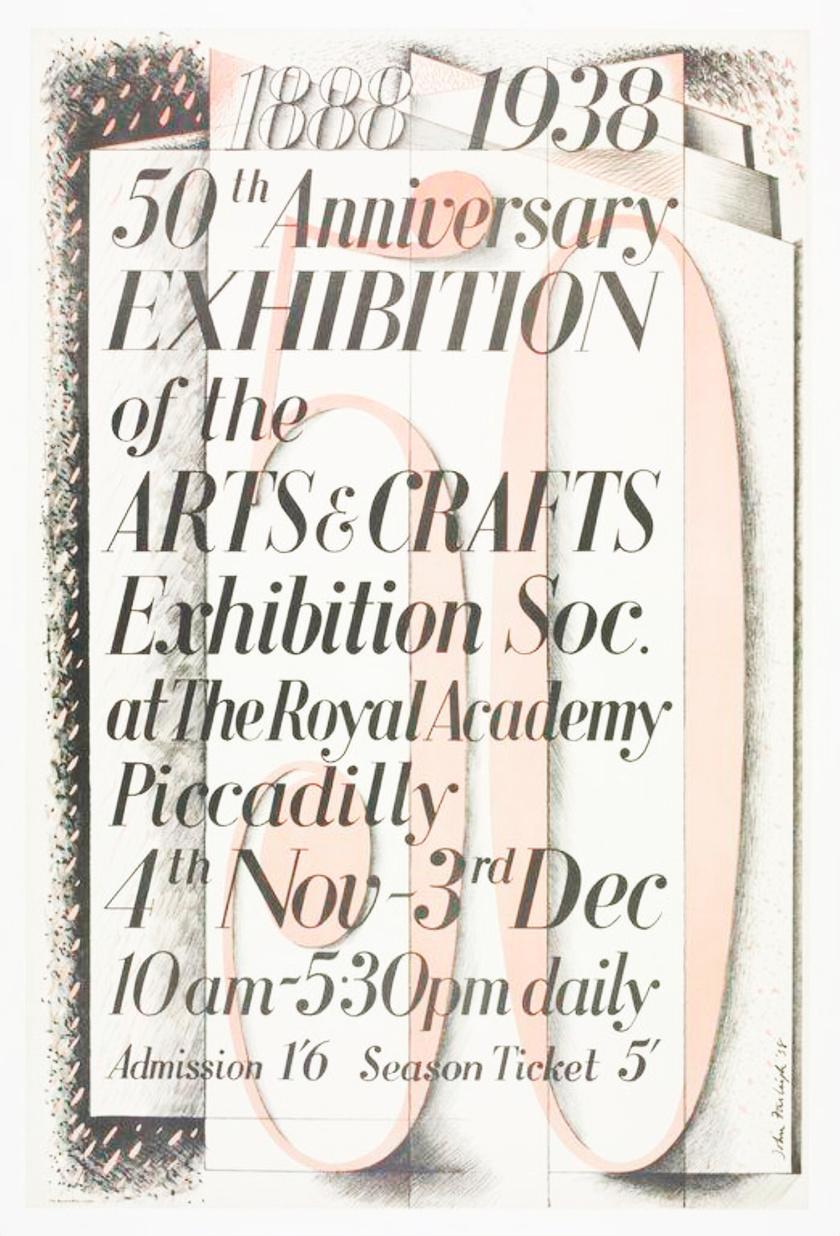

In 1900 Britain led the world in design and craftsmanship In 1887 our Society, then called the Arts and Crafts Exhibition Society, was formed by a group of artists, designers and architects, including Walter Crane, William de Morgan, W. R. Lethaby and Lewis Foreman Day, who saw the need for a body that would exhibit the best in decorative art, raise standards of workmanship and improve the lot of artisans. They believed the decorative arts to be as important as easel-painting and sculpture, but they had never been included in the exhibitions of the Royal Academy
The Arts and Crafts movement took its name from the Society but it encompassed wider range of organisations and activities that had grown out of concerns about the effects of industrialisation on design, workmanship and the lives of ordinary people It advocated design reform, changes in the way things were made and the simplification of everyday life. It struck a chord and developed a large following. Its values and achievements helped to shape the world we live in today.
By the end of the century, Arts and Crafts furnishings were to be found in every middle-class home in Britain. The art schools were led by people from the movement. Design in Europe and North America was influenced by it. The Viennese Secession followed the ideas of Charles Rennie Mackintosh. The Bauhaus set out from the ideas of William Morris. Ruskin was even read in Japan and encouraged the revival of folk crafts there. It has been said that its influence was felt right up to the 1950s, in the 1951 Festival of Britain and the design philosophy of Terence Conran.
In 1896 the death of William Morris, the president of the Society, deprived it of its driving force, and without his creativity, passion and energy it seemed to drift. Its 1912 exhibition made a loss and the 1916 exhibition was considered to be tame and repetitive After the First World War, few imagined Britain would abandon the factory system or that craftsmanship had the power to cure all social ills, and the Society was forced to reconsider its identity and purpose. One response was an attempted rapprochement between the artist and industry, another was withdrawal into a pure craftsmanship of solitary makers.

The first exhibits of the Arts and Crafts Exhibition Society had been designed by artists and made by others, sometimes in factories, and a point was made of crediting the maker as well as the designer. Walter Crane and Lewis Foreman Day had fierce disagreements about this, Crane insisting that the designer should make everything himself, Day arguing that, without some specialisation, both standards of design and standards of workmanship would decay Only in the 1920s did Crane’s ideas triumph, and there crystallised the now familiar notion of designer-crafts, in which the designer and the maker were one.
One of the Society’s original concerns, the relationship of the artist to industry, was taken up elsewhere In 1915, Lethaby, together with Harry Peach of the Dryad company and the shopkeeper Ambrose Heal, formed a breakaway group, the Design and Industries Association, which looked to the Werkbund in Germany, a large state-sponsored body that included industrialists, artists, designers and makers. In 1931, a British government committee directly addressed the question of how the artist could improve the standard of mass-produced goods Although its principal concern was industry, it had no doubt about the importance of the crafts, which was not surprising, considering that one of its members was the president of the Arts and Crafts Exhibition Society, Charles St John Hornby.
These concerns were bound to impinge on the Society itself, and there emerged a group of reformers, led by the wood engraver John Farleigh, who thought that it wouldn’t survive if it didn’t accommodate itself to mass production. The exhibitions of 1935 and 1938 cautiously included designs for industry, but not without rows and resignations.
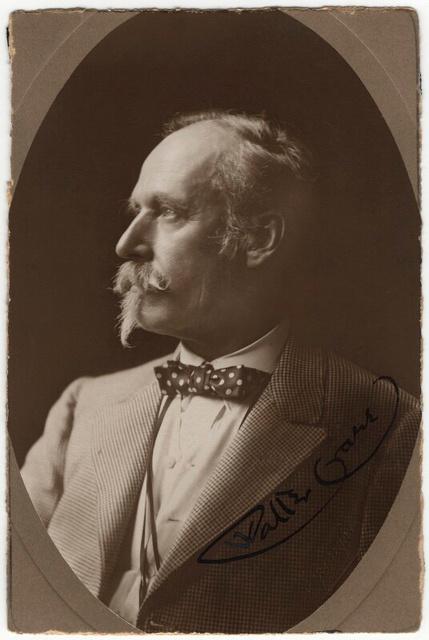
The Second World War challenged the crafts again as younger makers were called up for military service and the shortage of materials forced others to seek alternative occupations But the Society bravely continued to exhibit, and the 1944 exhibition at the Wallace Collection attracted 20,000 visitors, doubtless cheered up in a bombed city by a display of originality, beauty and creativity. Especially pressing at the time was the need for craft societies to work together, and the Society collaborated with five other national bodies to plan a permanent exhibition centre, which came to fruition after the war in the Crafts Centre of Great Britain. John Farleigh, its chairperson, had persuaded the Board of Trade to give it a grant, but he offered a hostage to fortune in the promise that it would be relevant to industry. Now that a distinct design profession had emerged and the crafts were produced by self-sufficient makers, it was a promise he couldn’t keep, and funding was withdrawn But after several changes and moves, the Crafts Centre emerged as a thriving independent body, renamed Contemporary Applied Arts.
Feeling the need to reflect the different conditions in which the crafts operated, and recognising that the old name might deter younger people, in 1960 we changed our name to the Society of Designer Craftsmen Today we are the one of the largest multi-craft societies in the UK.
Being a member of the Society gives designer-makers professional recognition, helps them develop their practice and links them in a network of many other craftspeople We have three levels of membership, Licentiate (LSDC), Member (MSDC) and Fellow (FSDC), who are supported through a range of initiatives including meetings, exhibitions, workshops and mentoring sessions. Members are chosen for their innovative designs and their craft skills, which you will see in the wide range of disciplines represented in the WONDER exhibition.
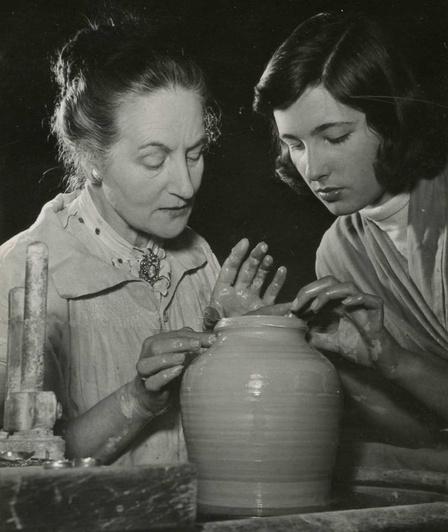
Blowing in the Wind, Levante Bowl
Adam Aaronson is a full time studio glass maker producing vessels and sculpture from his studio in Surrey.
The 'Blowing in the Wind' collection features simple forms adorned with two or three carefully selected colors, bringing a modern and upbeat twist to a traditional glassblowing technique. The inspiration behind this captivating collection comes from the feathers adorning the winged sandals of Hermes, the Messenger of the Gods in Greek Mythology Drawing from the style of Matisse's paper collages, Adam infuses his glass sculptures with a touch of artistic allure and timeless elegance.
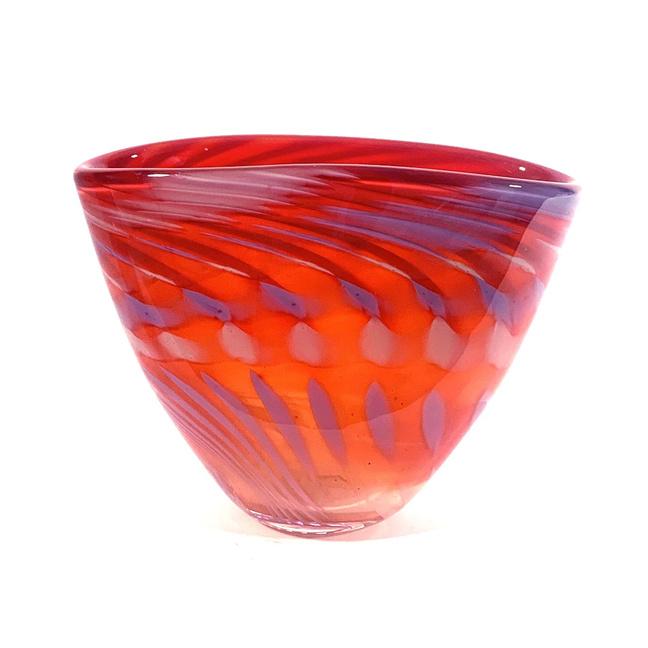 19 x 19 x 6cm. £595
19 x 19 x 6cm. £595


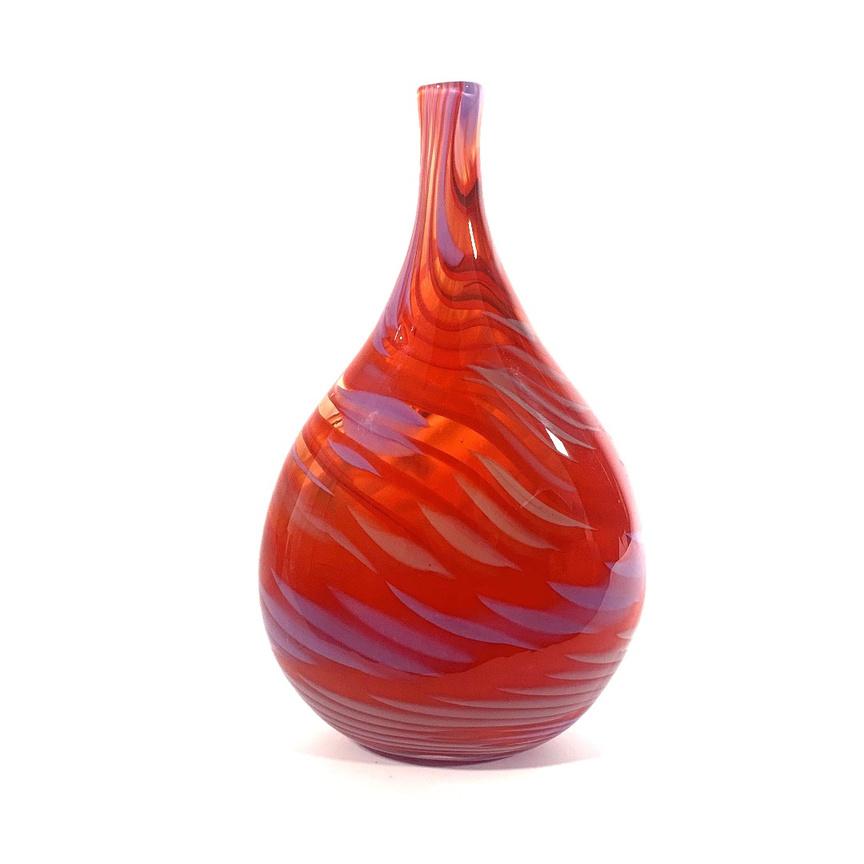 Adam Aaronson FSDC Glass Making & Stained Glass
Right: Blowing in the wind - Levante fan vase 19 x 10 x 16cm. £395.
Adam Aaronson FSDC Glass Making & Stained Glass
Right: Blowing in the wind - Levante fan vase 19 x 10 x 16cm. £395.
Red Star Argosy
60 x 40cm. Mixed media collage on canvas ground. £250
Elizabeth Ashurst is a textile artist using paint, paper, silk, thread and glue to create stitched wallhangings and panels, paintings and silk scarves. The interplay of light and colour is a key influence in her work.
She has been a frequent visitor to central and Eastern Europe since 1998, spending 8 months in Poland during lockdown with her husband She found this disruption to her life and practice in West Sussex to be immensely rich and stimulating, transporting her to a different culture and changing her perspective of European history and its relationship to Britain. Traveling light, taking only a sketchbook, minimal art equipment, iPad, and phone – she has recorded the changes which have taken place since the fall of communism in 1989 to the present day and this has provided her with a rich source of inspiration.
Moving from stitch to writing, drawing, paint and collage has enabled her to express ideas with greater clarity.
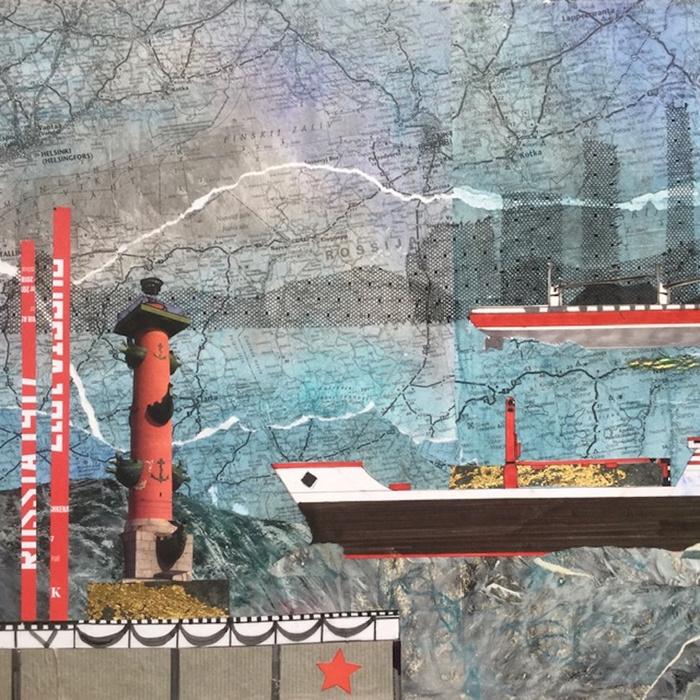


 Top: Making Waves. 100 x 30 cm. Mixed media, printed and painted paper, lino print, net. £250.
Top: Making Waves. 100 x 30 cm. Mixed media, printed and painted paper, lino print, net. £250.
.
Self-portrait II - What chance do I have, with a glass eye, a borrowed ear and a scar on my face?
45.5 x 55.5cm. Fused, float and antique glass. £1100
Fabrizia Bazzo is an artist and maker using glass as the main medium to transform and express her thoughts Translating dreams into glass has always been her way of entering a world of wonders and, more recently, a way to escape the reality of the times in which we currently live.
Fabrizia specialises in architectural glass installations, including commissions for both public and private locations against specific briefs as well as works for exhibitions Each piece of work is unique and she enjoys creating works where her imagination and quiet ambition can be channelled simply to satisfy her own curiosity.
Self-portrait II is constructed from layers of fused, float and antique glass, hand painting, acid-etched and laminated with further decorations using decals and transfer image on photographic emulsion.
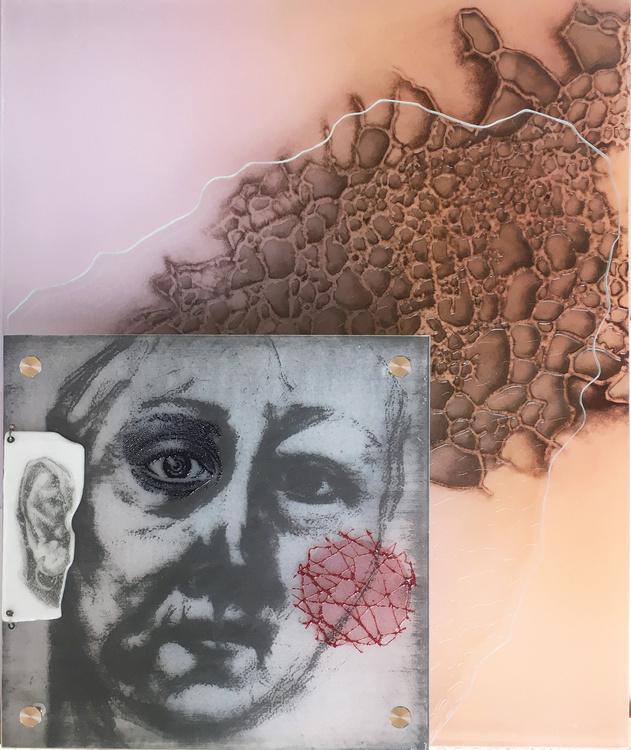
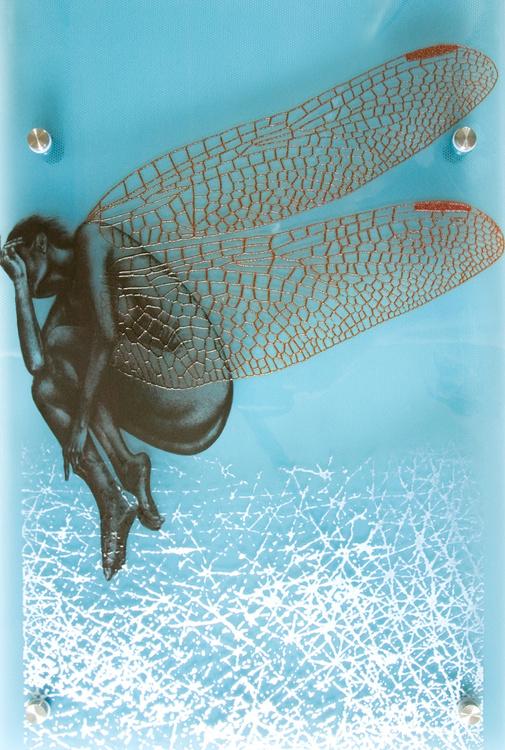
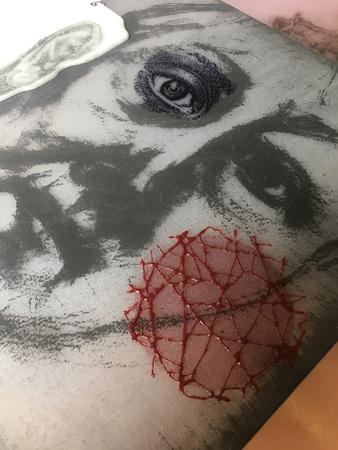

 Above and right: Depth of Transparency. 39.5 x 69.5cm. Glass panel, handpainted, screen-printed glass powder. £750.
Above and right: Depth of Transparency. 39.5 x 69.5cm. Glass panel, handpainted, screen-printed glass powder. £750.
Jennifa Chowdhury is a Winchester-based textile artist and researcher. Drawing inspiration from her background in printed textiles, light, shadow, and movement play a fundamental role in her process-driven creative practice She uses sustainable materials such as Khadi paper made from cotton rag, and Nepalese Lokta paper, which consists of fibres from the inner bark of a Lokta bush. These materials are manipulated through digital technologies.
Through the exploration of Islamic geometric patterns, her recent work explores contemporary pattern design that has evolved from more traditional practices The significance of pre-established geometric and proportional design principles linked to Islamic philosophy and metaphysical dimensions distinguishes the geometric patterns which are central to her work. In addition to their mathematical elegance, these designs are always based on grids constructed with simply a ruler and compass
 50 x 50 x 5cm Khadi, White Rag and Nepalese Lokta paper (Gold) £750
50 x 50 x 5cm Khadi, White Rag and Nepalese Lokta paper (Gold) £750

Left: 16-Fold Rosette, geometric tube lamp. 70 x 15 x 15cm. Layered, laser cut, Khadi, white rag and Nepalese Lokta paper (gold). £350.

Below right: Unfolding.100 x 50cm. Nepalese Lokta paper (gold). £750.
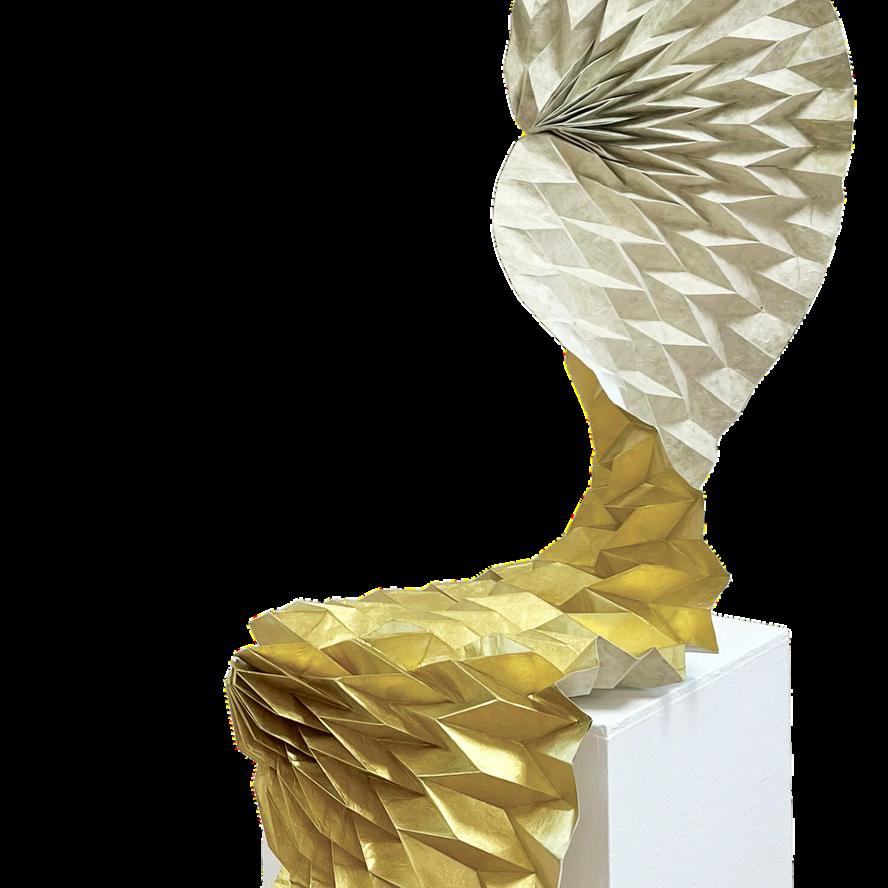
Sangam III. 50 x 50 cm. Khadi, White Rag and Nepalese Lokta paper (gold). £750.
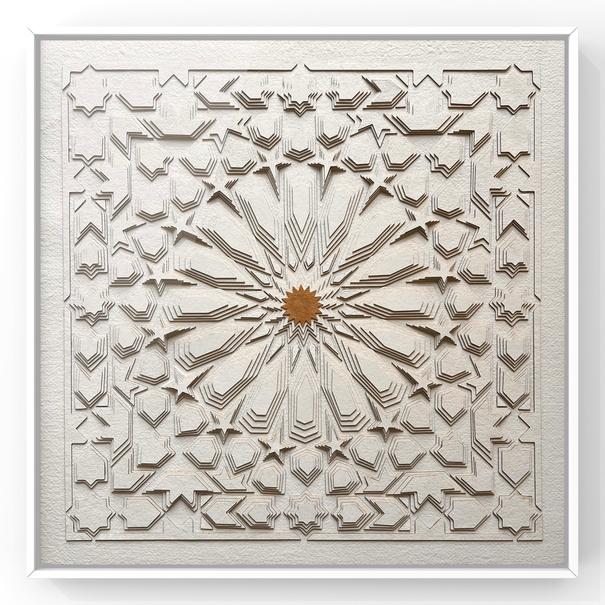
25 x 30 x 50cm 3D Felted sculpture in Wensleydale, Silks and Merino on turned holly base £1800 (inc stand)

Julia Desch is a feltmaker and poet. Her love of nature and relationship to the natural world informs everything she creates, including hand dyed and felted textile hangings, sensory wheels, unique Wensleydale fibre garments, poetry and watercolour paintings. Julia works and hand dyes her own Wensleydale wool fibre from her own purposely bred sheep She is a British Wool Artisan Licensee and passionate about inspiring others through heritage skills.
For Julia, 'Wonder' is a continual companion and inspiration in all her pieces, through unexpected results, experimentation and discovery of deeper interpretation The wonder lies in the precision of nature and its unstinting support to humanity in its framework for our being. Words and poems often inspire her work and her own compositions sometimes accompany her pieces.

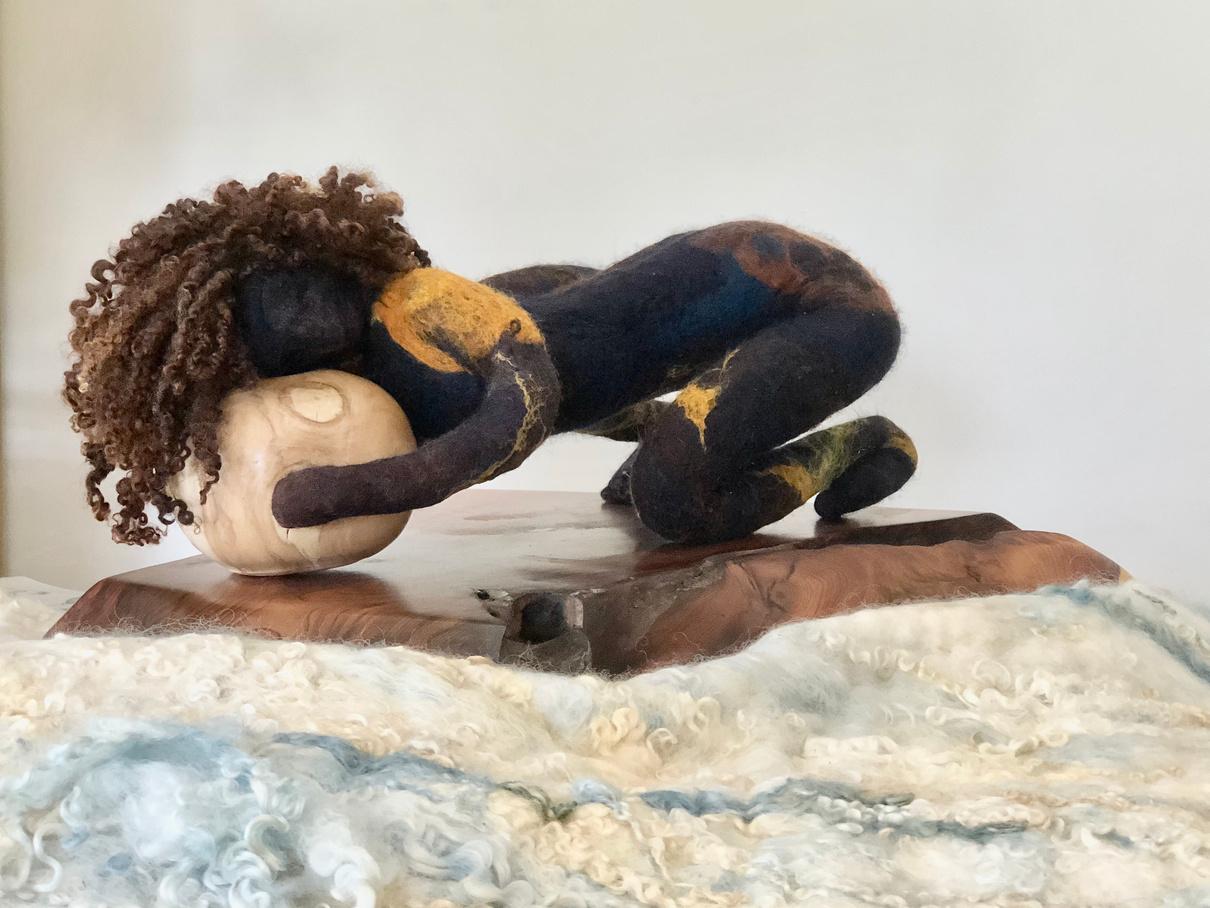

 Clockwise from top left: Pan At Tipping Point (detail). 25 x 30 x 50cm. 3D felted sculpture in Wensleydale, Silks and Merino on turned holly base. £1800.
Infinity (detail). 140 x 110cm. 2D Wall hanging in Wensleydale, Hand dyed Indigo on White Ground. £3500.
Clockwise from top left: Pan At Tipping Point (detail). 25 x 30 x 50cm. 3D felted sculpture in Wensleydale, Silks and Merino on turned holly base. £1800.
Infinity (detail). 140 x 110cm. 2D Wall hanging in Wensleydale, Hand dyed Indigo on White Ground. £3500.
90 x 90cm Print assemblage of 36 eco prints overlayed with a screen printed acrylic sheet £699

Sheila de Rosa is a printmaker whoses work takes a critical view of social, political and cultural issues and is motivated by the evidential ironies of photography and the technical complexities of printmaking.
Using a variety of materials she plays with reality asking what is fixed and real about time; what effect are humans having on the natural world; and does the world consist of interconnected and interwoven lines? She makes complex mixed media artwork using a variety of materials and processes with printmaking as a central core but with photography often as the starting point.
Her piece 'Synthesis Report' showcases eco prints capturing the beauty of plant life during Lockdown 2021. Overlaying the prints is a Doomsday clock drawing, emphasizing the urgency highlighted in the IPCC's 2023 climate change report.
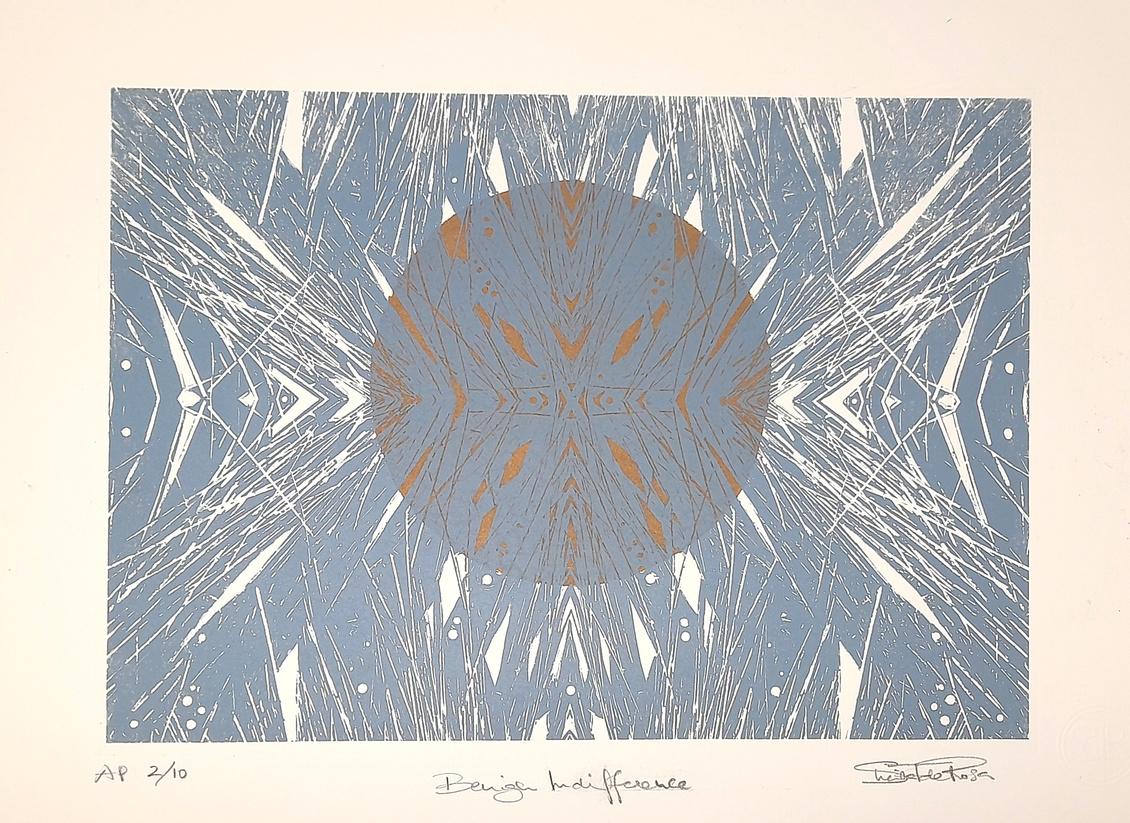
Above: Benign Indifference II (detail). 42 x 30cm. Intaglio photogravure print with monoprint layer. £450.
Benign Indifference III. 30 x 42cm. Eco print, monoprint & relief photogravure. £450.


Enamelled picture, 24 x 24 x 1cm, £225
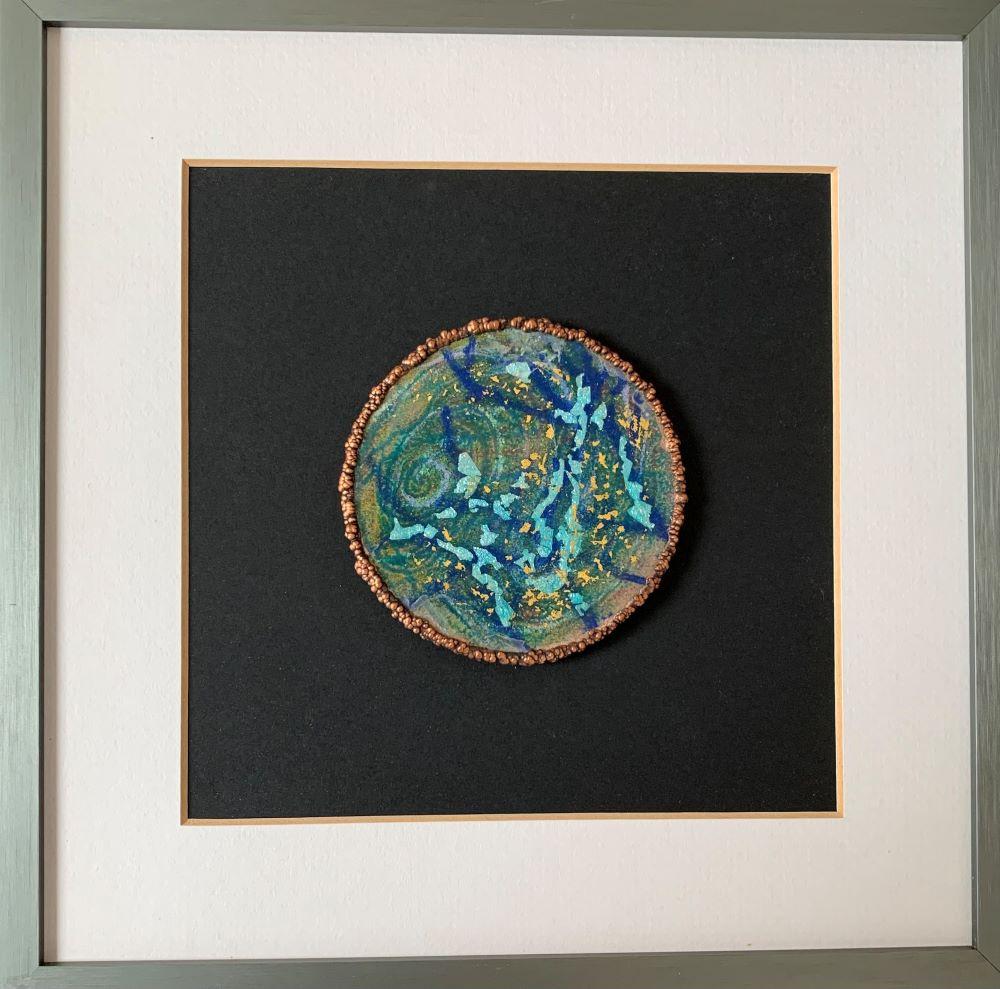
Silke is a jeweller and enameller with a love for the wonderful colours of the natural world. She is passionate about the environment, and the protection and preservation of wild animals and insects.
Jewellery pieces are made of enamel and/or precious and semi-precious stones, or electro formed organic materials in copper. Often the enamelled pieces are combined with precious and semiprecious stones.
Recently Silke has begun making enamelled bowls from copper and also enamels spun copper bowls. Her fascination with colours, crystals, stones and metal continues to inform all her work.

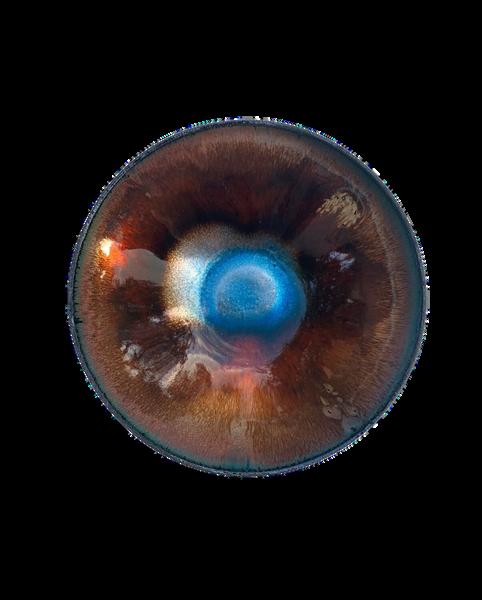
Clockwise from top left: Abalone Yin Yang. 5 x 5cm. Electroformed pendant with Abalone shell. £195
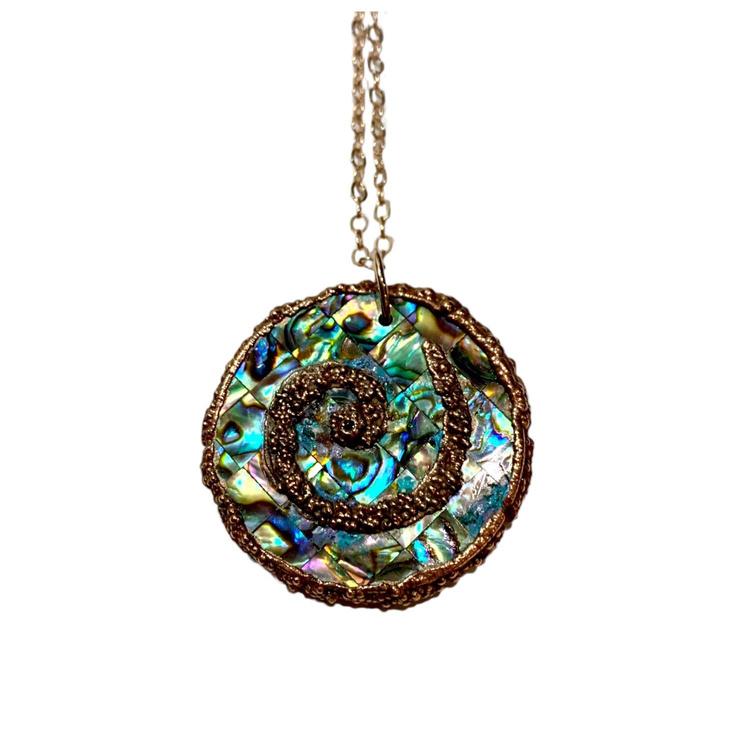
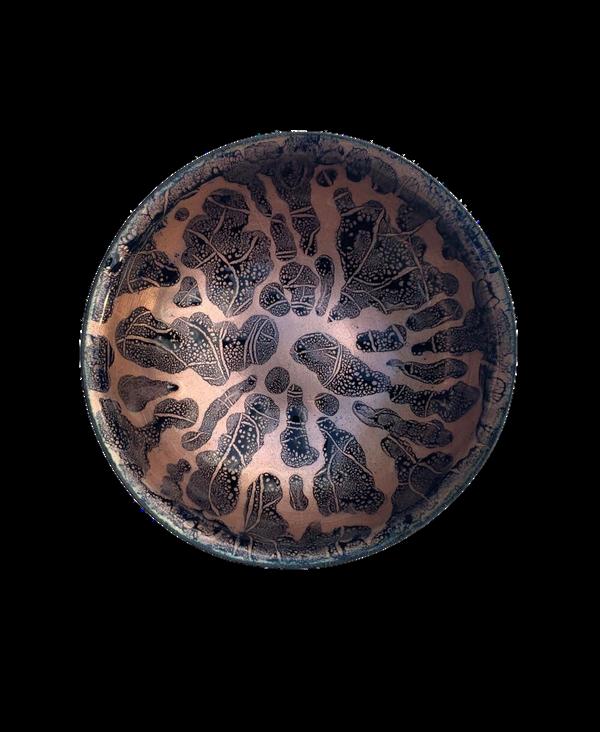
Turquoise Bowl. 15 x 15 x 3.5cm. Enamelled bowl. £165

Black patterned bowl. 9 x 9 x 4cm. Enamelled bowl with foot. £145
Sunset Bowl. 11 x 11 x 4cm. Enamelled bowl. £155
Amathia
40 x 10 x 10cm. Freestanding female form. £350
Ferri Farahmandhi is a ceramic artist who was born and brought up in the southern region of Iran, where art is an integral and important part of their culture, and so has always played a big part in her life. Early childhood memories are of making miniature pots and dishes with clay that she collected from a big pond behind her house Once her own children were adults she went on to study pottery, completing a BA in London and, over the past twenty years, has been making figurative sculptures in her studio.
Ferri uses two different techniques to create her sculptures; in one, drawing and shaping the form on a thick block of clay and when hard, carving the extra clay out to achieve the required thickness and form. In the other she uses a press mould technique.
She is fond of the symbiotic relationship between the human form and nature, and the glaze as if oxidised from years of being submerged underwater, highlights the idea that change is a fundamental and ever-present natural force that affects us all




 Clockwise from top left: Supreme. 40 x 20 x 12cm. Head mounted on a pole. £850.
Avisa. 49 x 23 x 20cm. Female torso mounted on a pole. £650.
Clockwise from top left: Supreme. 40 x 20 x 12cm. Head mounted on a pole. £850.
Avisa. 49 x 23 x 20cm. Female torso mounted on a pole. £650.
33 x 24
Nefertiti Dreams
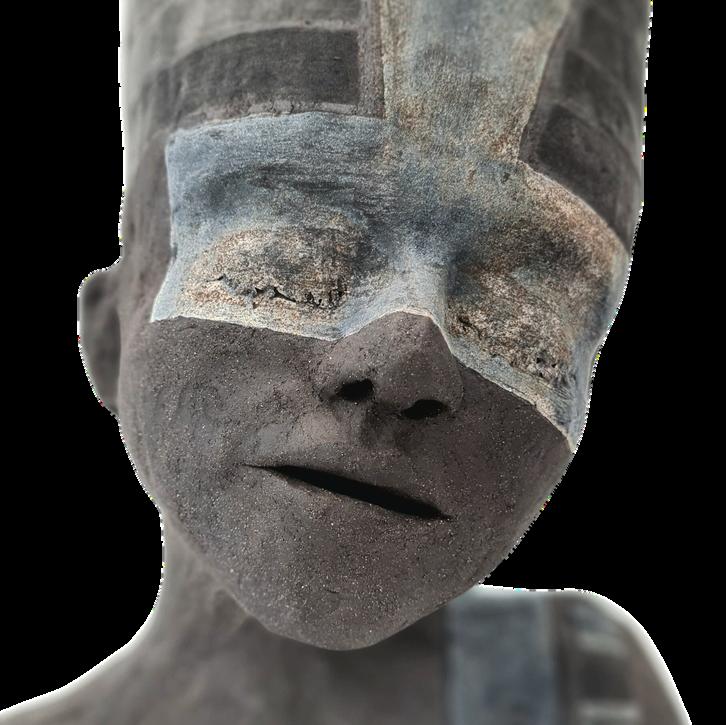
Harriet Ferris is a ceramic artist who explores form through hand building with stoneware clays which are then fired with a muted palette of glazes, oxides and slips From her very first encounter with clay it was all about the handling of this wonderfully versatile material and it is this physical engagement with the medium that inspires her as she explores clay's endless possibilities. Getting her ideas down quickly, almost like a 3D sketch, she can can then work on refining the details. Working spontaneously and initially at speed means her work takes on a life of its own as she plays with form, texture, light and shade
Through storytelling and artistic expression she breathes life into her ceramic sculptures, leaving viewers enthralled by the narratives they convey.
Clockwise from right: Nefertiti Dreams. 33 x 24 x 17cm (incl base). Black ceramic sculpture mounted on an oak base. £810.

Did He Know? 25 x 16cm x 16cm (incl base). Black ceramic sculpture mounted on an oak base. £560.

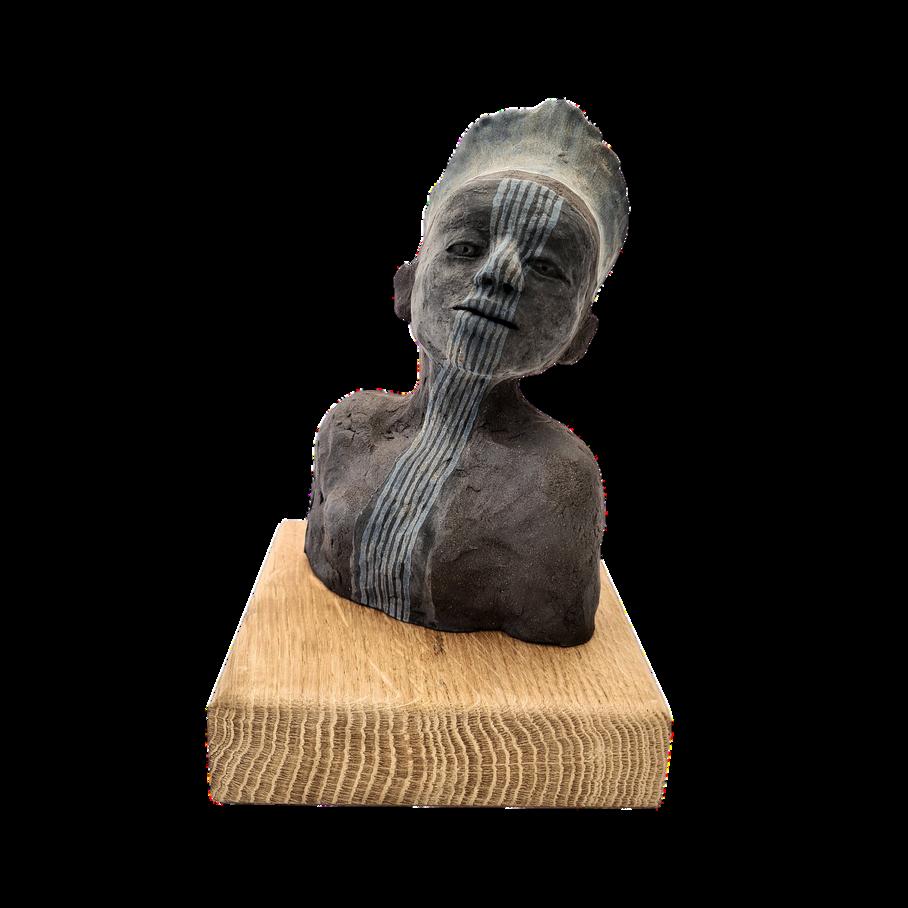
Did He Know? (detail)
 Harriet Ferris MSDC Ceramics
Harriet Ferris MSDC Ceramics
Sunset
152 x 55 x 10cm. Re-purposed vintage window with fused glass seascape. £1650
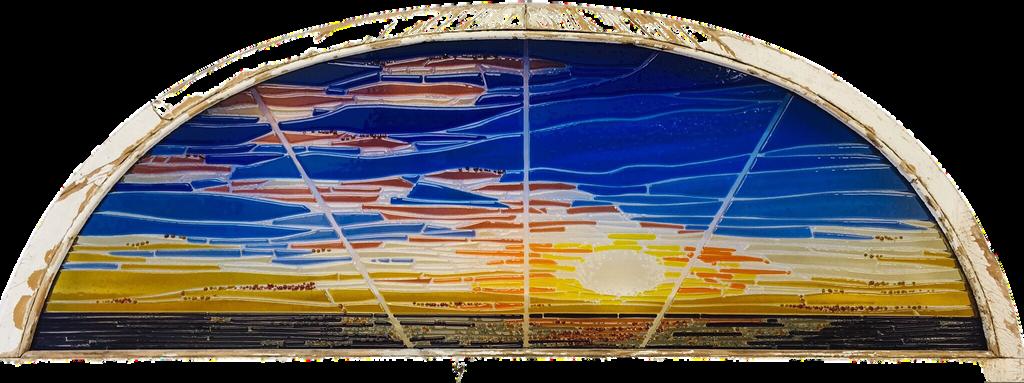
Nancy Goodens is a glass artist, creating seascapes and landscapes. Her work utilises the colours and textures of glass, fusing these materials and techniques as a fine art medium. She has an intuitive and painterly response to an image or drawing, further enhanced by the surprises created during the glass firing process
She is currently on a 6-month sabbatical from teaching and this is enabling her to pursue some larger scale projects as well as explore new creative ideas that she has been considering and planning for some time
'Sunset' is part of a large-scale window project using vintage windows that are often damaged or broken. Nancy likes the concept of re-purposing a beautiful old window no longer wanted, to create something new and vibrant but still retaining the age and beauty of the original window, thus celebrating the original craftsmanship of its construction She removes the panes, repairs and then re-glazes each of them with her own fused glass artwork of seas and skies.

Above: Porthmeor. 148 x 140 x 10cm. Re-purposed vintage window with fused glass seascape. £4250.

Sunset (detail). 152 x 55 x 10cm. Re-purposed vintage window with fused glass seascape. £1650.
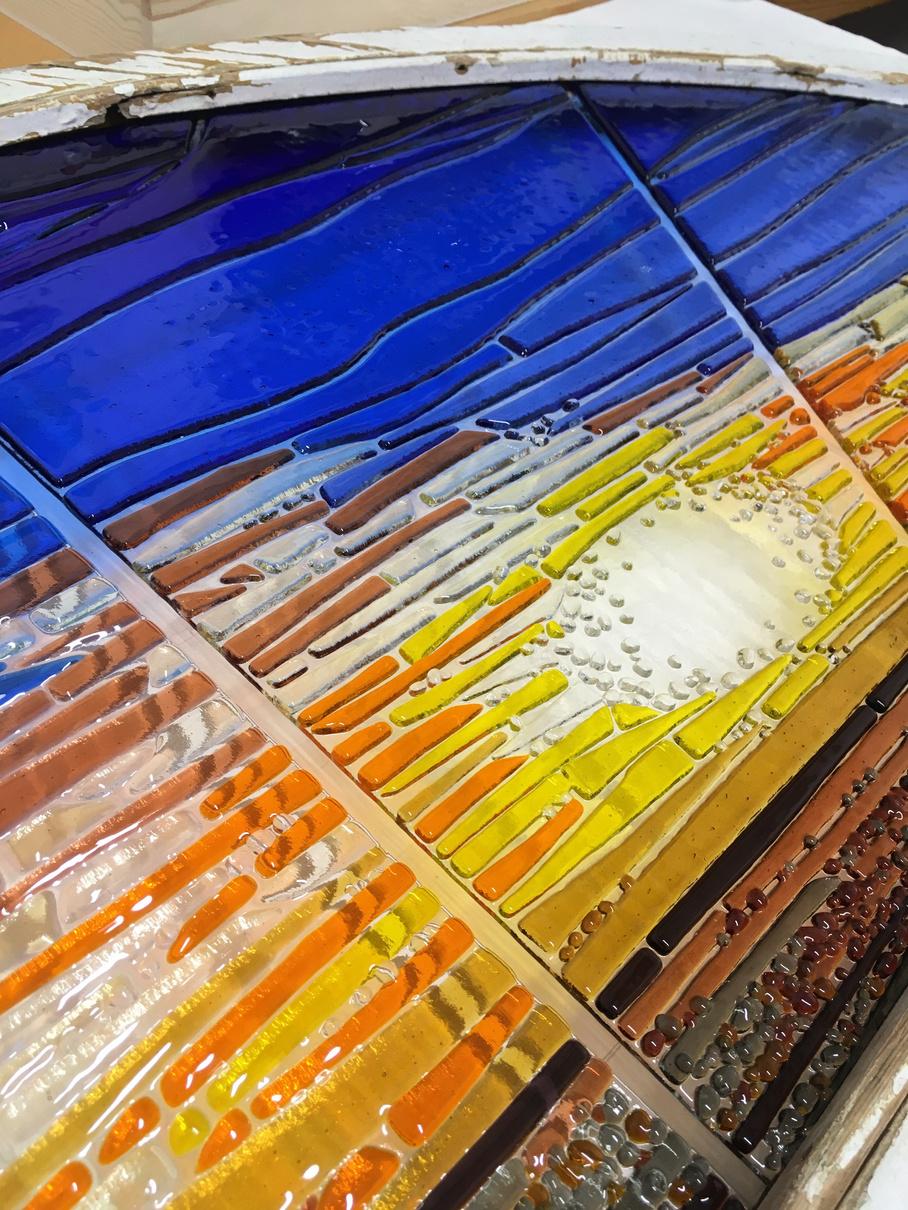
Escarpment (detail)
180
Charlotte Grierson is a hand weaver who has long been interested in the relationship between materials. At the beginning of this year she embarked on a new development of her artwork, building on research into coastal dynamics, rock formations and coastal erosion.. Choosing a point on the South coast around Seaford and within the Seven Sisters range as her starting point, she has developed a body of work based on this theme She sees a connection between the forces that create the landscape and the way in which yarns react to shape fabric when woven together.
The cliff face is largely made up of chalk with flints and other materials embedded into it. The paper yarns and horsehair used in her piece 'Escarpment' reflect this both in colour, in various whites and creams, and also in the range of textures created by different thickness of yarns. The incorporation of these creates tensions causing distortions which add to the nature of the hanging.
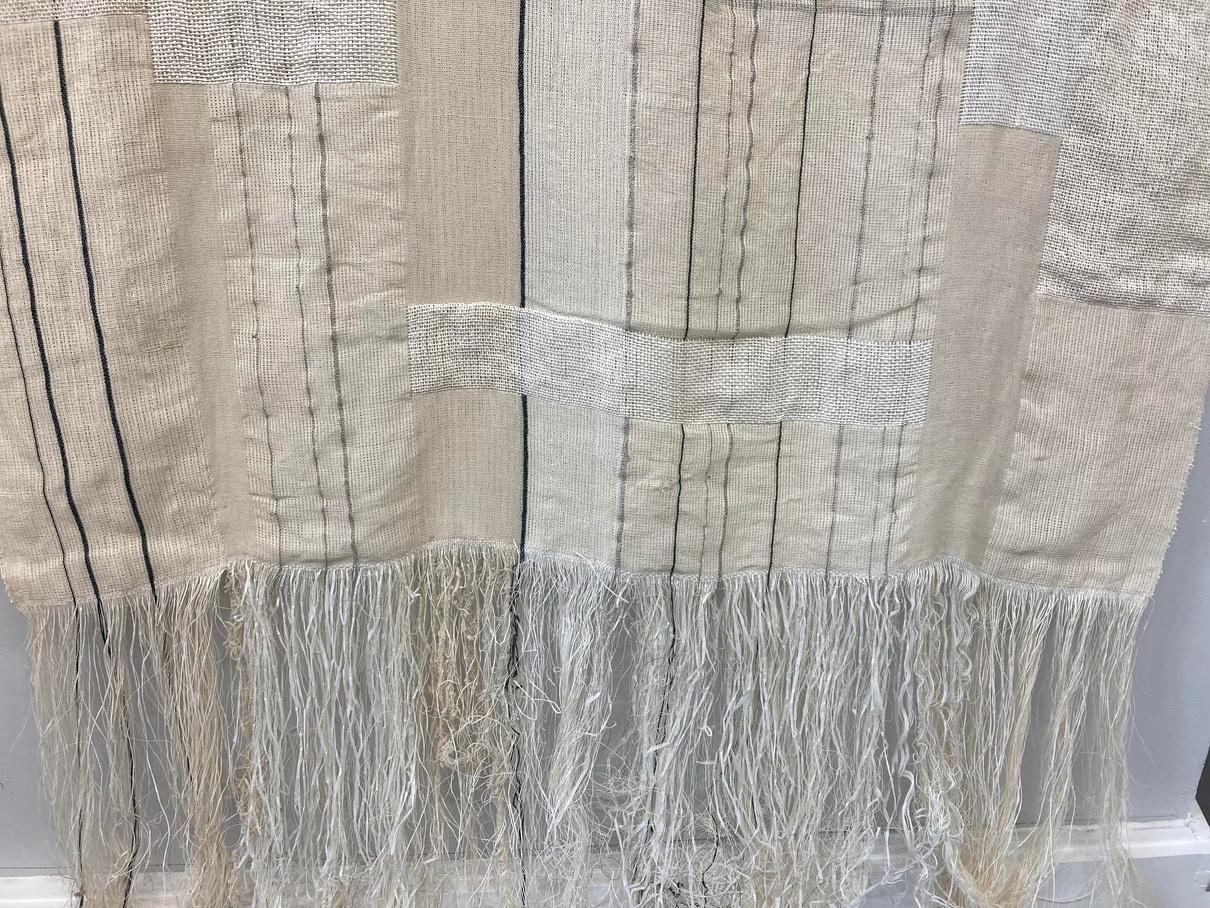
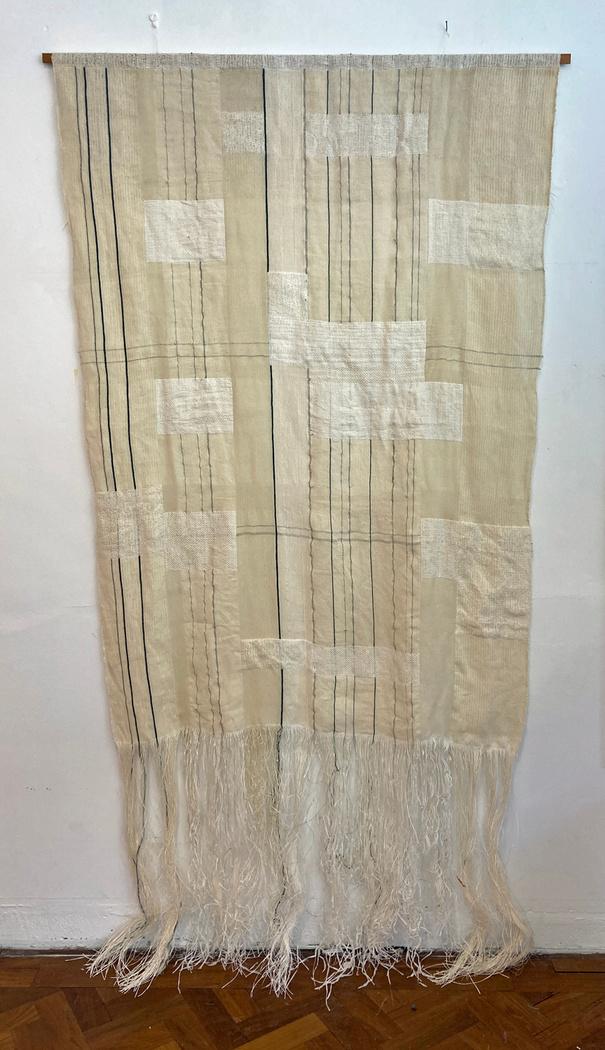


Jillian Harvey is a printmaker who combines nature and travel inspiration into compositions that also includes pattern. Graduating in Fine Art BA Hons (First) majoring in print making, today she prints in her studio. Her Ideas start off as sketches/photos but it's the detail within these that piques her interest and creates an abstraction Colour plays an important part of her work, mixing her own water based inks and developing her screens in her dark room
This body of work exhibited in WONDER is based on the word 'Silk'. The influence is the work of silk artisans in Japan which in turn is then made into the kimono.
Her work can have up to 20 layers and the smallest of detail can have one layer A print takes days to create and will have many variations – she will have several prints on the go at any one time. She always prints extra ideas with different elements to see what new passageways appear and how the ink lays for future but produces very few final prints to ensure their uniqueness
Silk I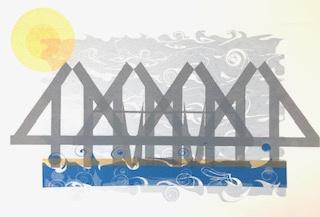

Above: Silk. 70 x 100cm. Framed Screen Print. Fabriano Unica 220 gsm. Water Based Ink. Edition 1 of 2. £450.
Silk II. 70 x 120cm. Wall Hanging on Fabriano Conservation Paper 170 gsm. Water based ink. Edition 1 of 1. £350.
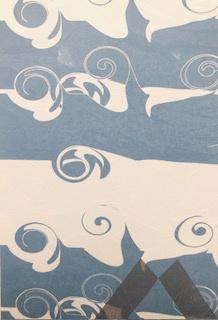
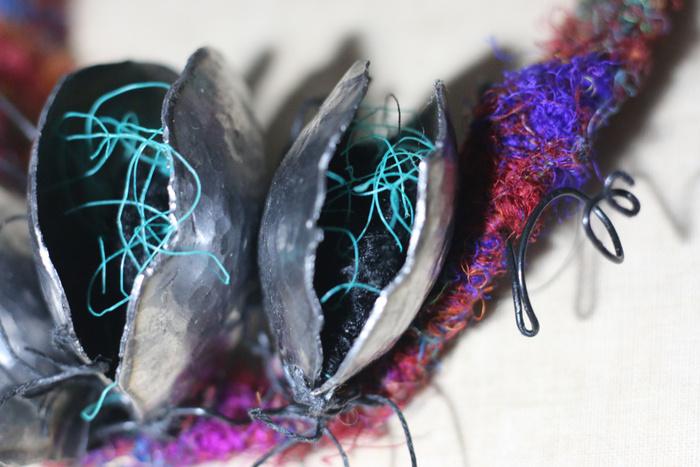
Banksia Necklace (detail)
15 x 8 on 68cm woven cord. Steel and mixed recycled materials. £275
Sam Harvey is an Australian artist, living and working in London. She makes sculptures, drawings and collages inspired by the world around her, especially the colours, movement and diverse quirkiness of the fragile gardens of the sea.
After a trip back to Australia in 2022, the recent 'Banksia' collection evolved from drawings Sam made of the native banksia seed pods and plants. She was inspired by the uniqueness of each pod and the way they open, often exposing velvety elements within the strong woody structure.
Sam has been experimenting over many years with combining stitch and steel, considering them the ultimate in contrasting media and enjoying their juxtapositioning. The Banksia pieces are hand formed and constructed from steel and mixed recycled media, the selection reflecting a life-long concern about the effects of her choices on the environment.
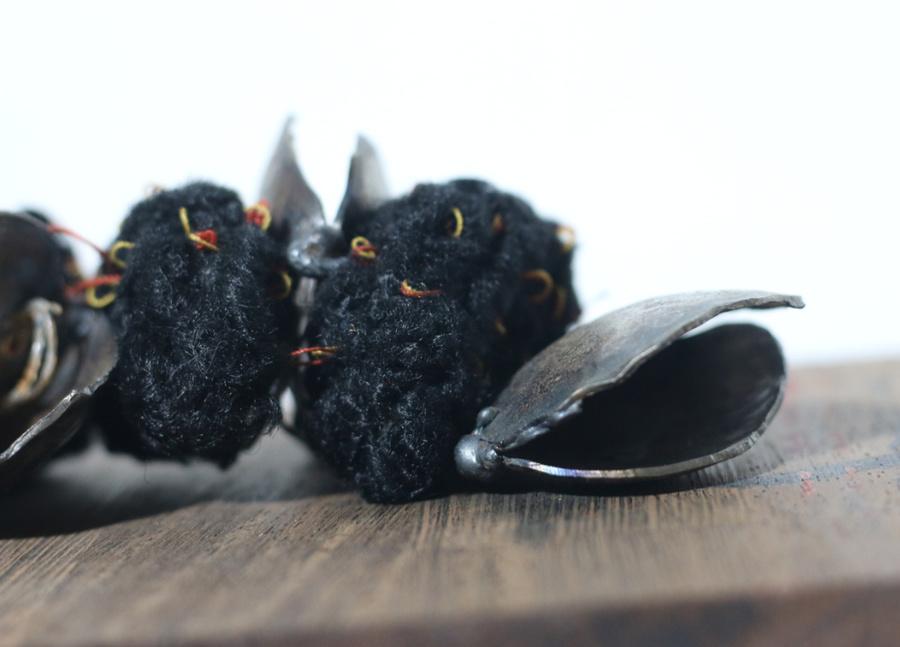

Above: Banksia Pods. 35 x 10 x 60cm. Inspired by Banksia Pods and informed by drawing, these hand formed and constructed pieces are created from steel and mixed recycled media. £250.
Banksia necklace.15 x 8 on 68cm woven cord. Steel and mixed recycled materials. £275.
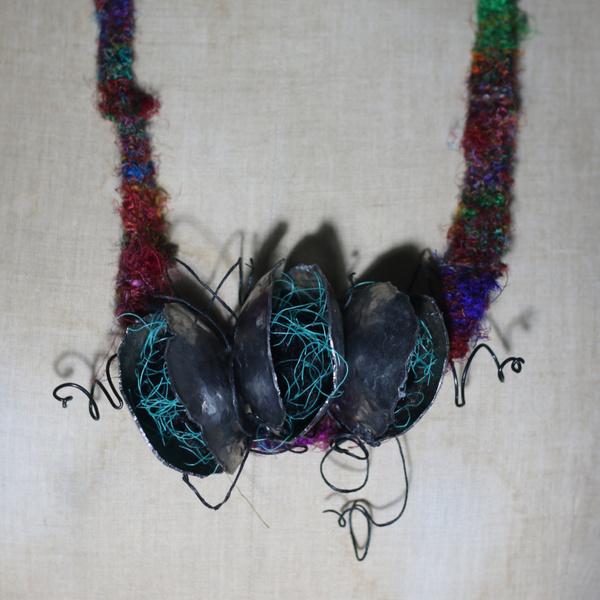
28 x 33 x 5cm Hollow circular vase, sycamore with walnut inlay £298

Kevin Hutson is a wood turner working from his studio in West Sussex. He has been making and designing circular hollow forms for thirty years. Over that period, with the evolution of his work, the hollow forms have become more refined including the use of inlays and various surface textures.
Kevin's time is spent mainly on the lathe but he also sketches and is inspired by natural forms surrounding his studio. Major influences have also come from ceramic forms, including visits to the V&A Museum to view the Song dynasty Chinese porcelain bowls as well as from sculptors such as Barbara Hepworth and David Nash.
Years of experience of making circular hollow forms has given Kevin the skills to also now design and create square hollow vases which were inspired and influenced by his study of the Art Deco period
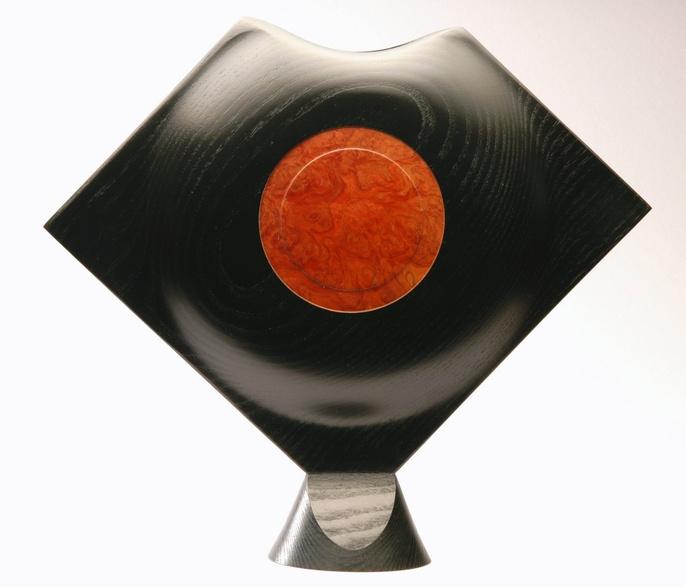

Clockwise from top left: Spalted Oblong form. 40 x 10 x 18cm. Oblong form in Spalted beech with Black ash bowl. £235.
Black and white vase. 29 x 35cm.. Circular hollow vase. £295.
Black and white oblong form. 40 x 10 x 15cm. Ash black and white hollow form. £245.

Walnut with sycamore inlay square vase. 31 x 36 x 5cm. £295.

Aran Illingsworth is a textile artist focussing primarily on portraiture using hand and machine stitching, applique and found materials. Her technique, developed over more than a decade, might be described as ‘painting in thread’. A primary aim of her work is to draw attention to the plight of disadvantaged and vulnerable people, including women and children in poverty and deprivation, refugees and the homeless.
Aran's works are created methodically, step by step, using photographic images to provide a skeleton or framework as a basis for the artwork itself Texture is developed by overlaying cloth with stitching over and through the underlying applique layers
Her current preoccupation is with the homeless and their pets; animals with whom they find an emotional relationship which is notably absent in general from their lives.
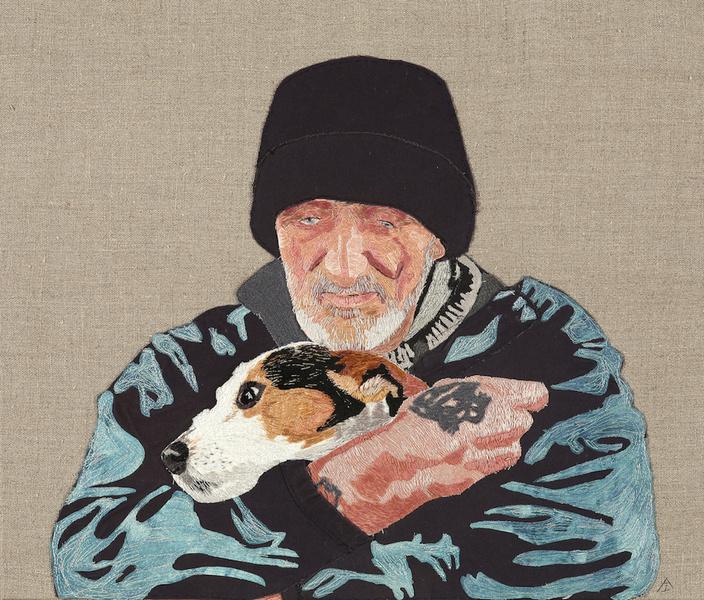 The man and his best friend
The man and his best friend
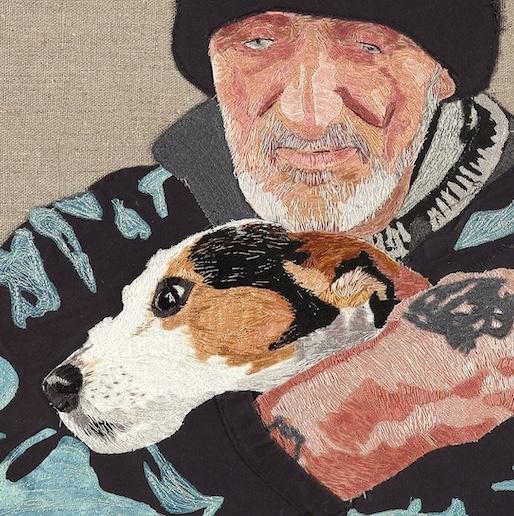
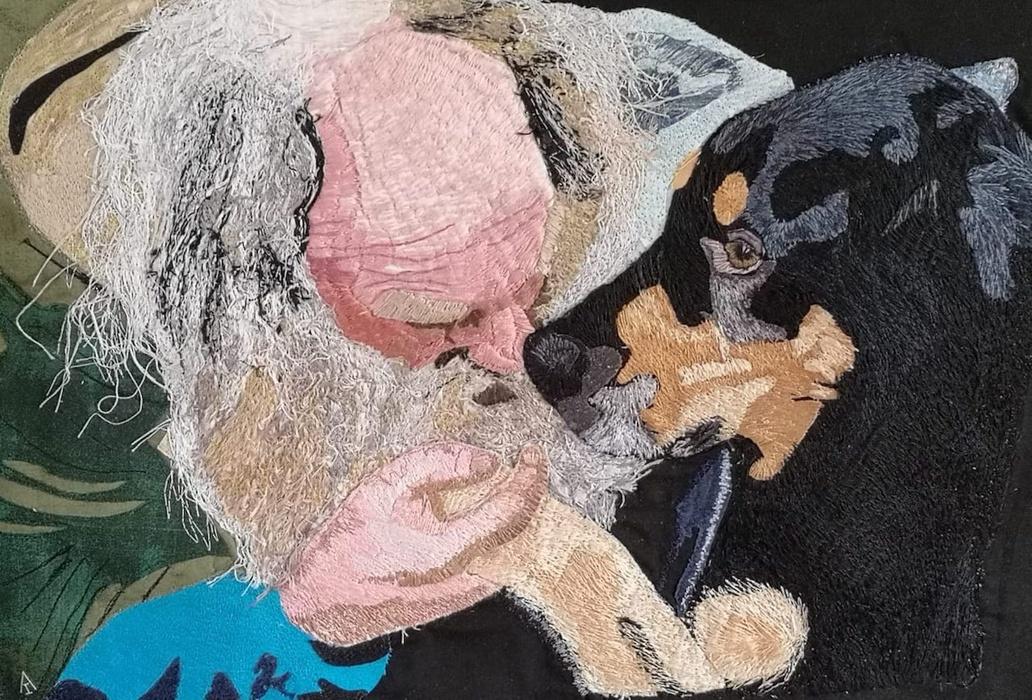
 Above: The Man and His Best Friend II. 30 x 44 x 2cm. Textiles and thread. £850.
Above: The Man and His Best Friend II. 30 x 44 x 2cm. Textiles and thread. £850.
60 x 60cm Mixed media mosaic set into a rusted barrel ring £1950

Denise Jaques is an award winning artist, based in Surrey She makes contemporary shimmering mosaic art for the home and garden Often working to commission, Denise creates site specific pieces for exhibitions, private clients, as well as commercial artwork for both interior and exterior spaces.
Her work has a strong sense of colour, pattern and rhythm and plays with the idea of distorted reflections She explores scale and dimension by working on a range of projects from large scale pieces of public art and sculpture to fine art pieces for galleries and exhibitions.
Each collection has a different starting point and inspiration, which is then developed by selecting appropriate materials and techniques to push forward For her entries in WONDER, 'Rust and Slate' uses a found rusted barrel ring and welsh slate as the starting points of the palette. In 'Hydra Bubbles' and 'Hydra Shard', the influences come from the constellation Hydra, the water serpent, flowing from the core of the earth to the stars above.
Rust and Slate
Above: Hydra Bubbles. Installation of mixed media mosaic Hydra Bubbles. Bubbles sold individually. Small, under 14cm £120. Medium, 15-20 cm £200. Large, 21-30cm £280.

Hydra Shard. 120 x 30 x 30cm. Mosaic sculpture suitable for exterior/interior. £3500.
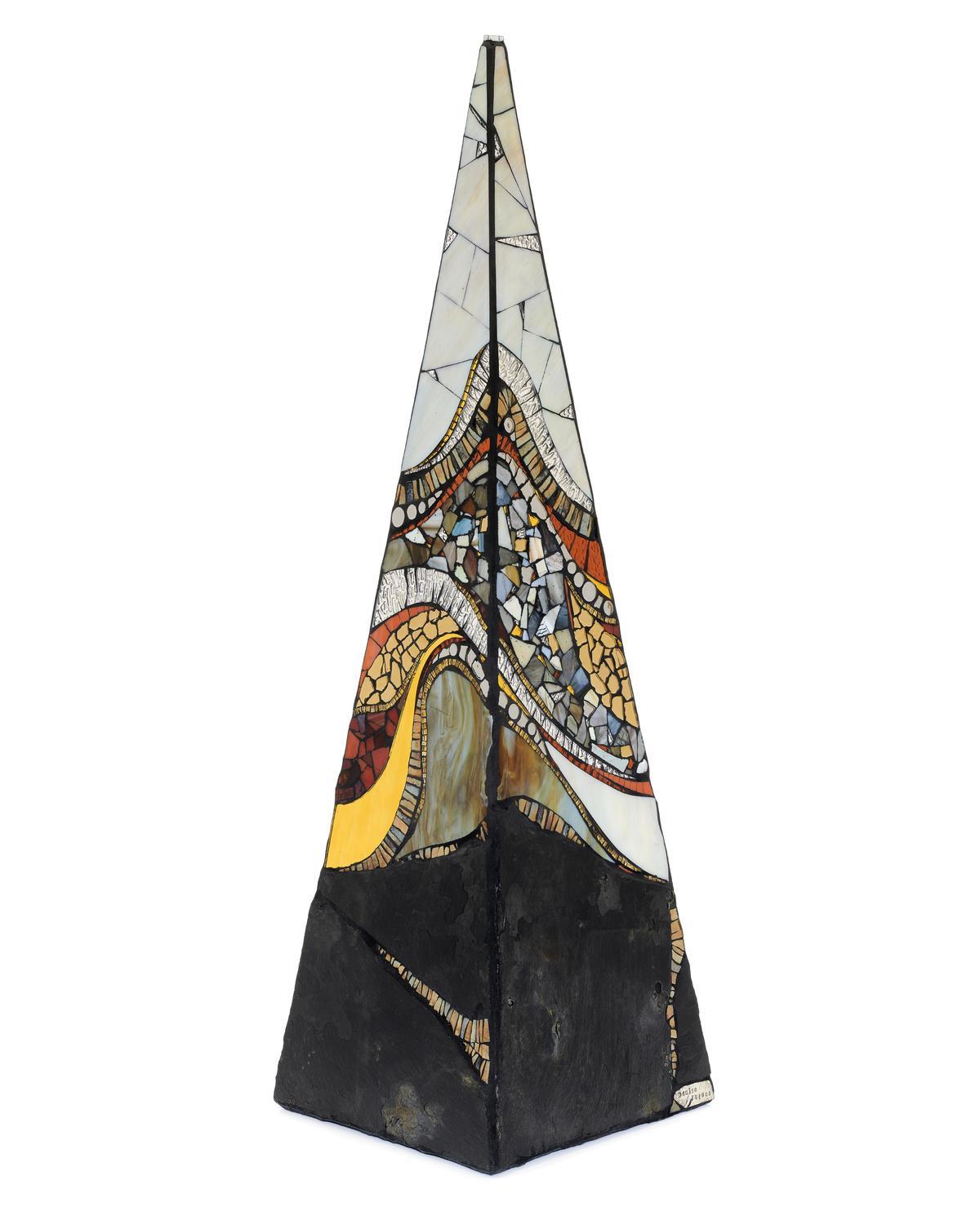
Stems and Stalks (detail)
50 x 15cm. Semi-tubular construction, hand and machine embroidery and mixed materials. £200 each, series of nine £1600
Marian Jazmik is a contemporary textile artist and keen photographer. Her work is heavily inspired by macro photography of the natural environment. Along with traditional textile techniques, she exploits the manipulation, construction and deconstruction of fibres and fabrics using a variety of heat treatments such as a soldering iron and hot air gun. Her creative journey evolves through experimentation and the creative outcome is abstract in nature. She is keen to promote the message of ‘re-use’ and ‘repurpose’ and this is a key feature of her highly textural wall art and sculptural pieces.
'Stems and Stalks' is semi-tubular in construction and created using both hand and machine embroidery along with various other techniques Materials including electrical wires and tubing, hair accessories, cotton buds, bathroom ‘scrunchies’ and garden mesh are deconstructed and heat treated to create the abstract surfaces of each piece.
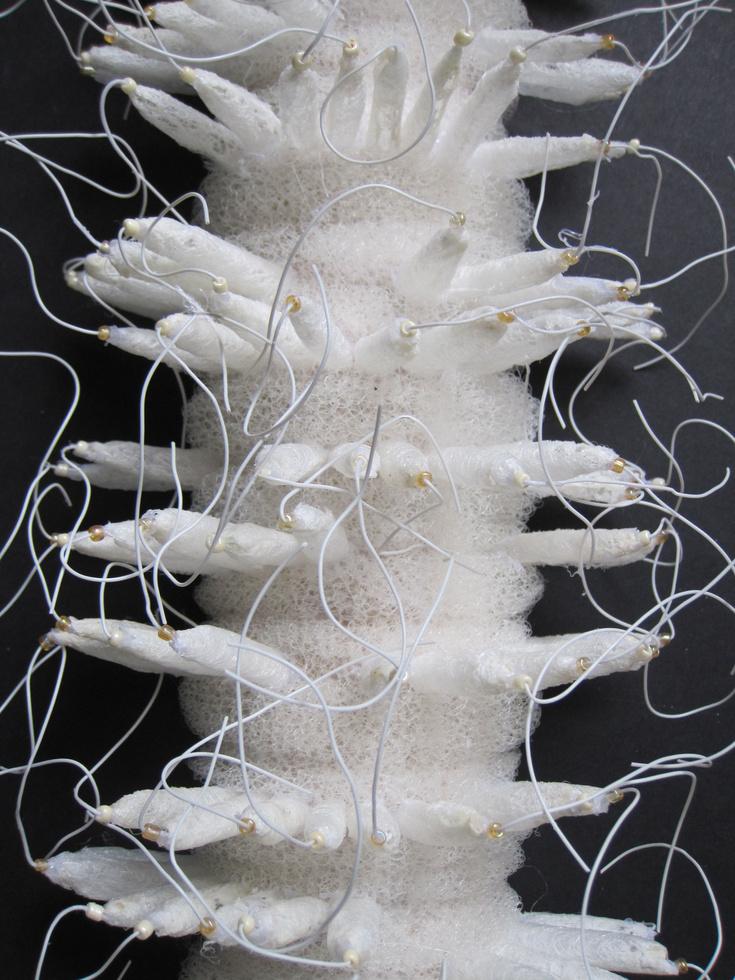
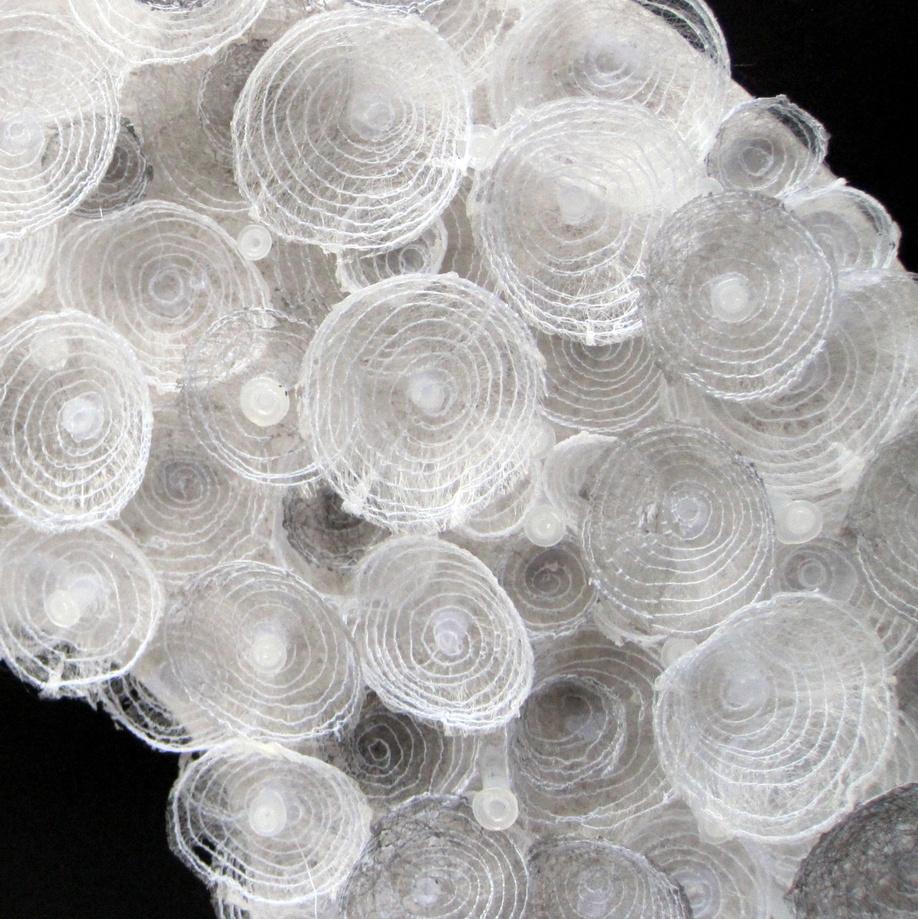

Above: Warped Earth (detail). 55cm. Circular piece, dyed, machine stitched and heat treated fabric along with heat treated plastic tubing. £495
Decay 1-3 (detail). 60 x 10cm. Three vessels on acrylic tubing £395 each piece.
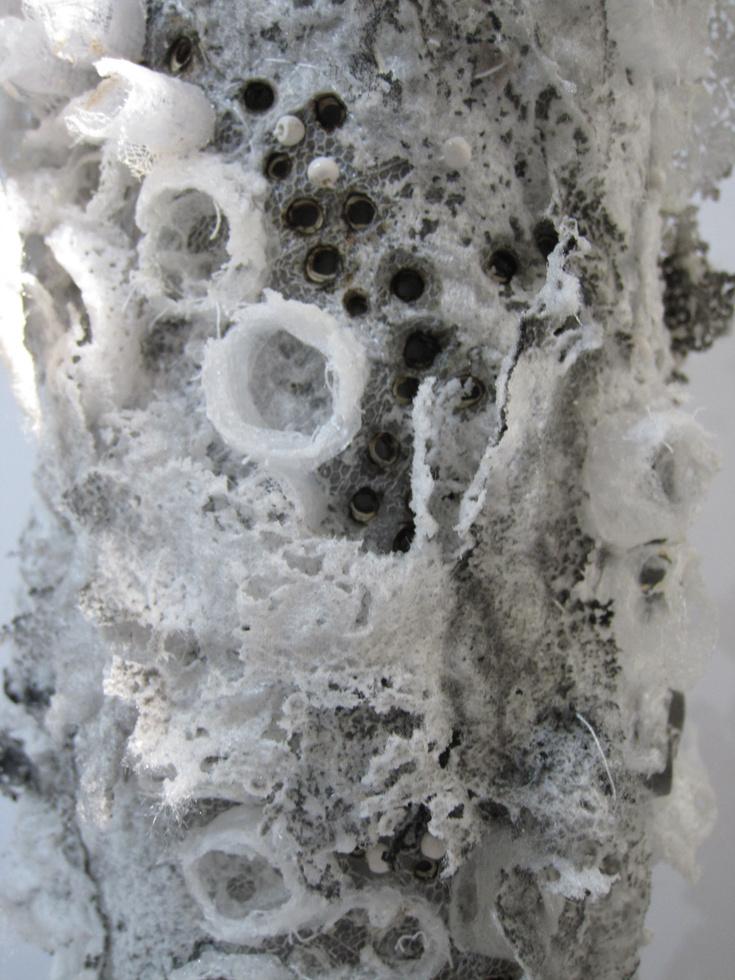

Brooch - Continuous
Sterling silver, 6.5 x 1.3cm, £350
Christine Johnson is a contemporary jewellery artist, exhibiting in the UK and overseas
Based on the Isle of Wight and in Surrey she is a Director of the Association for Contemporary Jewellery, and a member of a number of jewellery and craft organisations. She has recently founded a new jewellery school in Farnham, teaching jewellery courses and workshops at all levels
Christine has a particular interest in optical illusion and in kinetic pieces which enable the wearer to control the optical effect.
The design 'Continuous' represents the continuous nature of life Continuity of purpose; continuity in the face of loss; continuity despite global challenge; continuity of spirit in human endeavour, and the hope for the continuous nature of existence. The forms seen in this body of work found inspiration in nature, and also in ancient symbolic shapes, especially circles and spirals.
Clockwise from top: Pendant necklaceContinuous. 6.5 x 3.5 x 1.2cm. Sterling silver pendant on sterling silver chain. £350
Hexagon Chain Necklace. Hexagon Chain Necklace. £275
Ovals Necklace. 7.5 x 5.5 x 0.2cm. Sterling silver necklace. £295
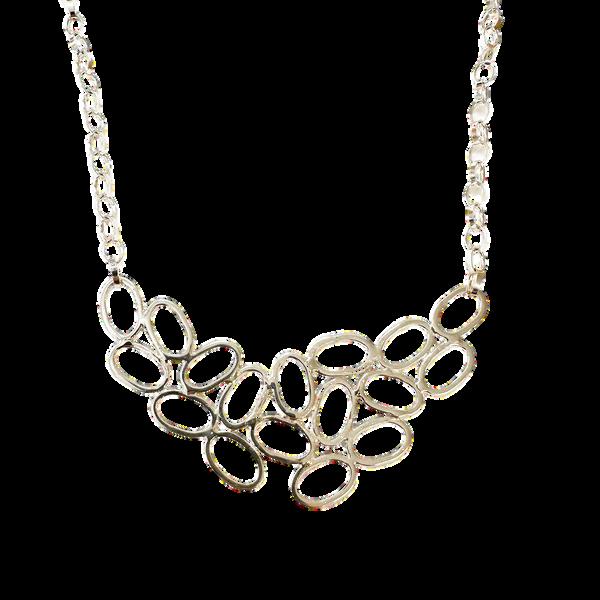

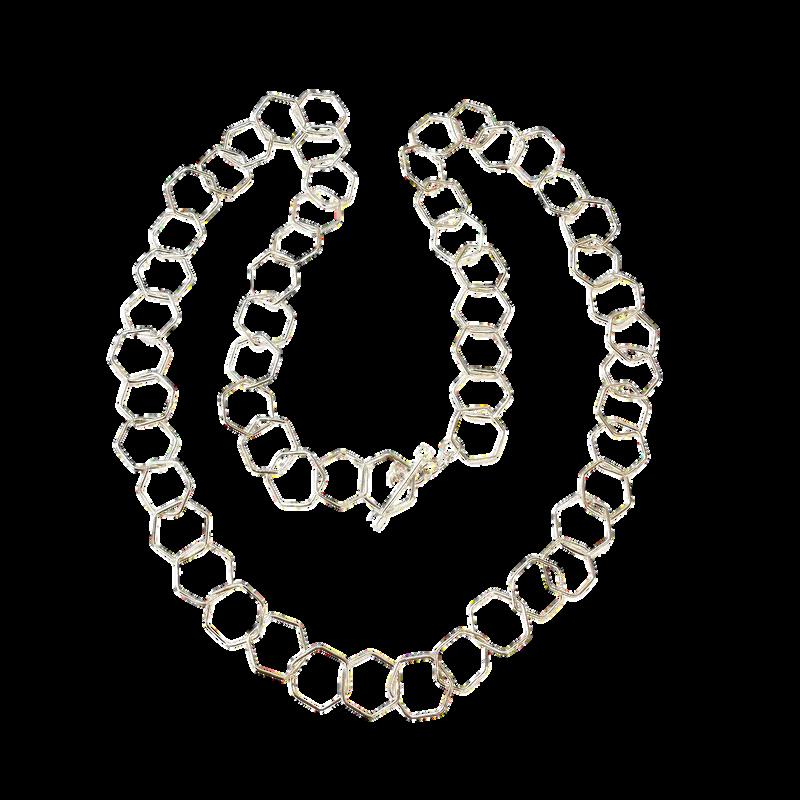
'Shaka' Bracelet (dots). 20cm. Sterling silver bracelet hidden connections. £350

'Shaka' Earings (dots). 2.5 x 0.6 x 0.22cm (approx.) . Sterling silver. £350


Abstract Landscape 1
15 x 15cm Hand woven tapestry £85
Margaret Jones is a tapestry weaver living and working in West Sussex. She also works at the professional tapestry studio at West Dean College of Arts and Conservation and teaches from beginners to masterclass level. She is founder and curator of Heallreaf, the well-known and highly regarded series of international tapestry exhibitions
Her 'Abstract Landscape' series comprises a number of small works which can be enjoyed individually as well as a group. The inspiration for these comes from the South Downs National Park.
Choice of colours in these pieces was important, nothing too dramatic, evoking the softness of the downs in all weathers. Blends of these muted shades are woven in tiny squares, each square representing a change in colour, form and light of the landscape. Each Abstract Landscape is made up of a group of coloured squares The warp is cotton but the weft is a mixture of wool, linen, cotton and every now and then a bit of silver lurex sparkle echoing the light on the River Rother.
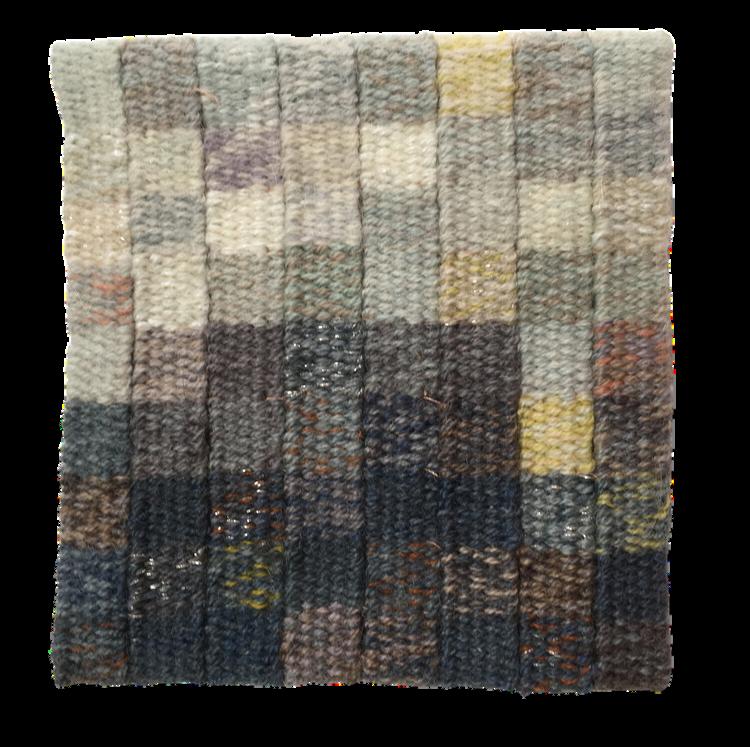

Abstract Landscapes. 15 x 15cm each square. Hand woven tapestry, evoking the softness of the downs in all weathers and lighting. Blends of these muted shades are woven in tiny squares, each square representing a change in colour, form and light of the landscape. £85 per square.
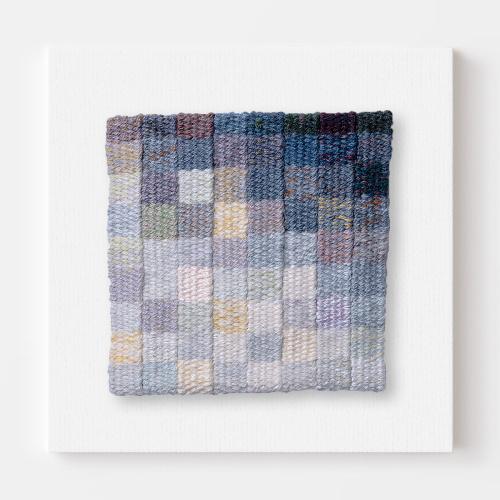


Sharon Kearley is an international woven textiles artist and an experienced lecturer and author. Her work investigates the emotional, physical and hidden line in the landscape, drawing on line as a connector of people, place and time Researching archive maps, forgotten paths and the rhythm of walking, Sharon’s work is underpinned by a strong narrative that investigates qualities of trace, fluidity, the ephemeral and the spatial through a playful and innovative approach to weaving, creating refined artworks for contemporary spaces, installation and exhibition.
In 'Alchemy', line travels through ‘nodal points’, along the Great Stones Way, exploring the physical path, alongside streams of hidden energy that flow beneath the surface linking three neolithic sites in the Wiltshire landscape. Drawing on archive maps and forgotten paths, Sharon contemplates on how these paths have remained a constant in a changing landscape, a connecting thread from communities of the past to those of the present

Above: Alchemy Series. 3D woven cubes in Japanese paper and hand dyed Indigo. Six cubes, 5 x 5 x 5cm. £540.

Indigo Streams I. 23 x 36 x 3.5cms. Framed woven artwork in Japanese paper and hand-dyed indigo. Bespoke oak frame. £225.
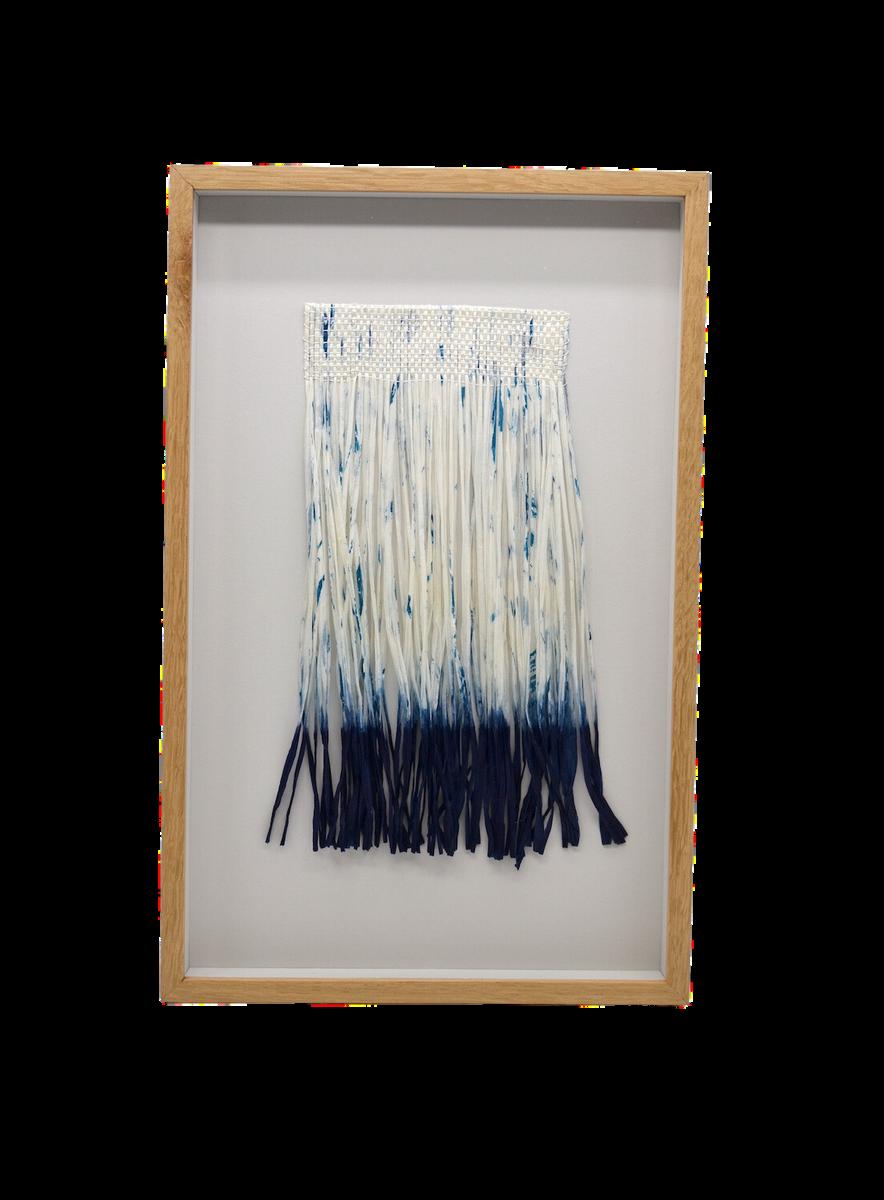
Tori McLean is an award-winning printmaker celebrated for her vibrant and dynamic use of colour. Her latest works are a fusion of contemporary and traditional printmaking techniques, exploring themes of sustainability and environmental awareness. Questioning our indiscriminate usage of materials, viewers are invited to contemplate the delicate balance between our modern way of life and the natural world.
'Plastic Fantastic?' woodblock prints depict the colours and shapes of plastic waste, celebrating the versatility of this material, whilst raising awareness of its environmental impact. With plastic production forecast to reach 1000 million tons by 2050, Tori created her woodblock prints using organic plywood to highlight the availability of alternative, more sustainable, biodegradable materials
Her visually compelling, lively prints serve as a call to action, encouraging viewers to consider their consumption patterns and reflect on ways to live more sustainably. Her art serves as a powerful reminder of the urgent need for responsible waste management and a more environmentally conscious approach to living

Top: Plastic Fantastic? II. 92 x 52.5cm. 95 piece woodcut print. £450.
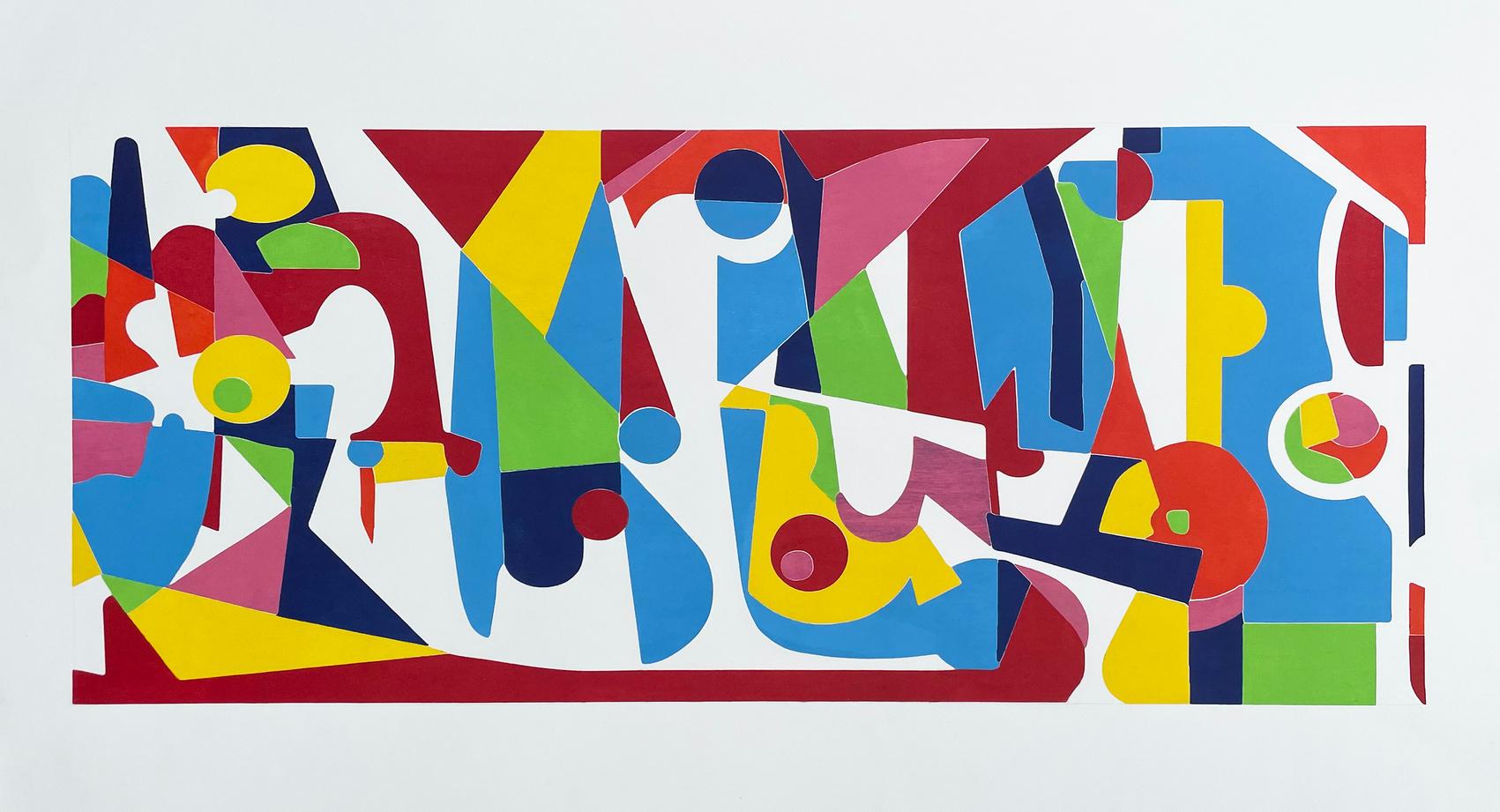
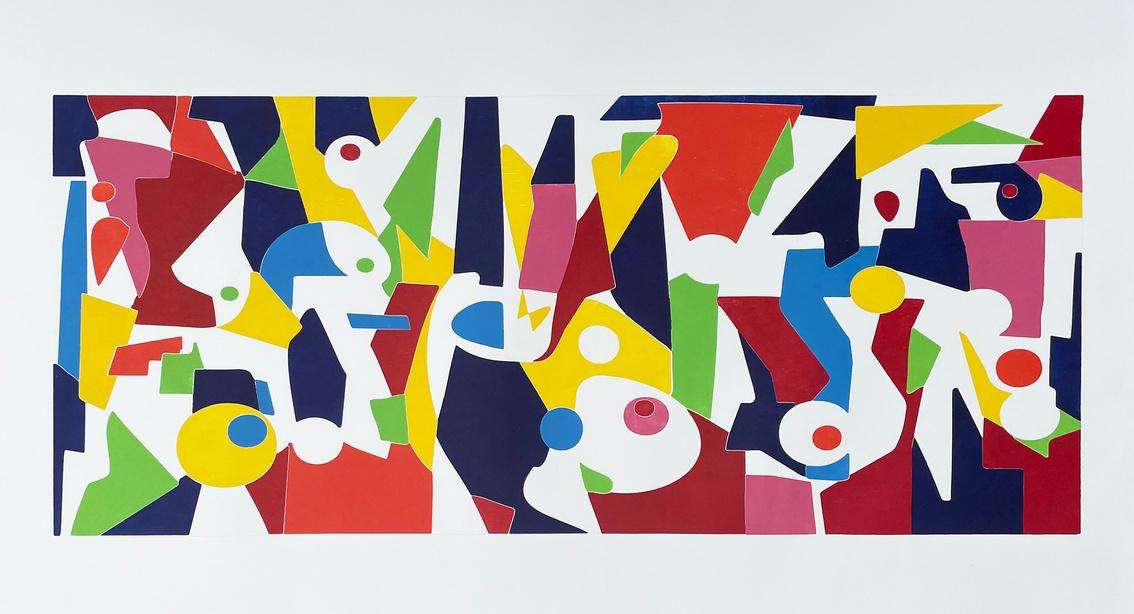
Plastic Fantastic? I (detail). 92 x 52.5cm. 95 piece woodcut print. £450.

78 5 x 2 5cm Wall-panel, hand-cut marquetry surface design using conventional dyed and reconstructed wood veneers £3400
Christine Meyer-Eaglestone creates wall-based artworks and functional pieces of art with a marquetry surface Prompted by a passion for interior/furniture design she enrolled on a cabinetmaking course where she developed her own method of creating designs using wood veneers, recognizing the space that marquetry could occupy as a contemporary visual medium. The award of a Crafts Council Setting-Up Grant in 2001 enabled her to establish a workshop in Leeds where she creates her unique wall-panels and pieces of furniture.
The marquetry design on all four pieces exhibited at WONDER arose through combining simplified architectural elements into geometric compositions. In the circular panel ’Tondo I’ as well as in ‘Vessel I’ Christine creates a dynamic composition by using diagonals, manipulating line, edge, colour and texture. In contrast, ‘Vessel II’ and ‘Vessel III’ appear calmer due to the repeated use of right angles As in architecture and music, which inspire her work, structure is central to her designs and essential elements are shared: balance, rhythm, harmony or discord.
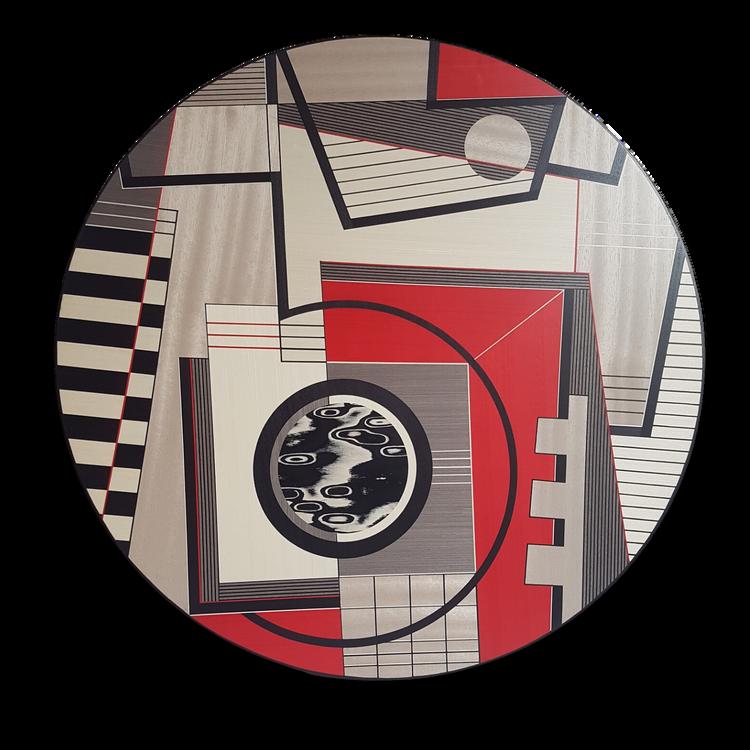

Clockwise from above: Vessel II. 36 x 18 x 12cm. Vessel with a hand-cut marquetry surface design using conventional, dyed and ‘reconstructed’ wood veneers Suedelined. £1480.
Vessel III. 27 x 27.3 x 12cm. Vessel with a hand-cut marquetry surface design using conventional, dyed and ‘reconstructed’ wood veneers. Suedeined. £960.

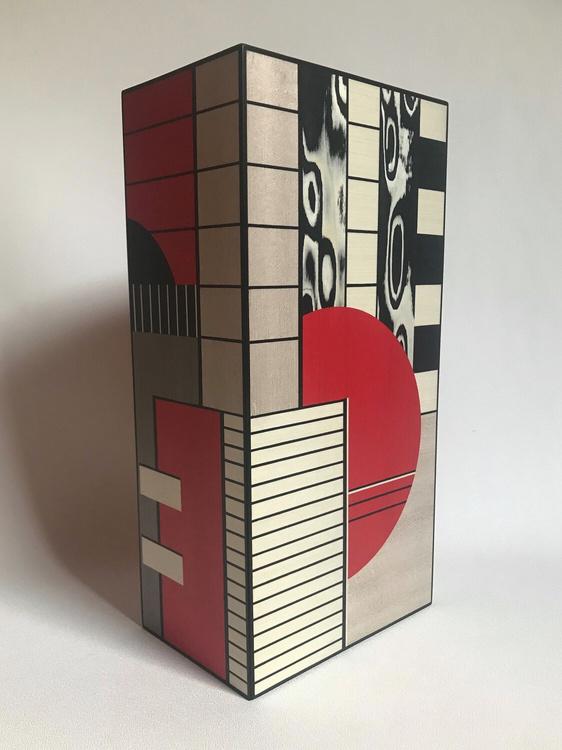
Vessel I. 40 x 27.2 x 12.2cm. Vessel with a handcut marquetry surface design using conventional, dyed and ‘reconstructed’ wood veneers Suedelined. £1420.
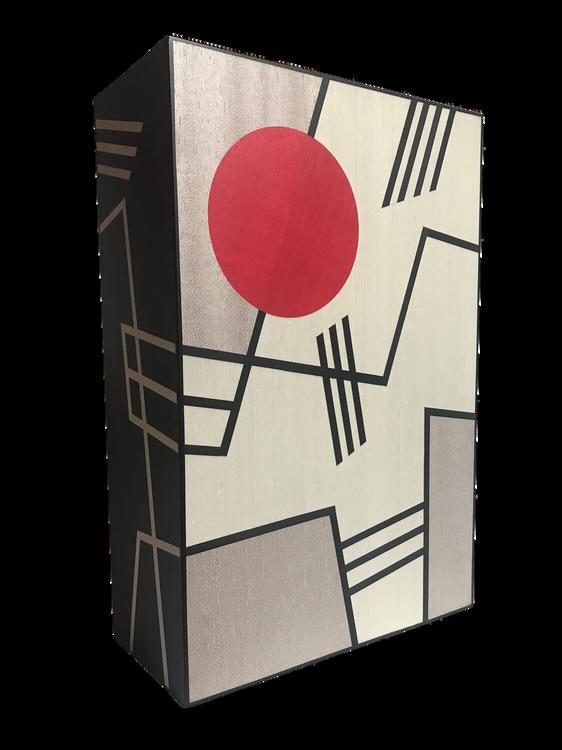
Mandy has been running a successful jewellery practice for forty years. Over the last twenty, she has also been developing work in felt and intends to focus more on this in the future. Taking wool as a natural, sustainable and versatile raw material, she transforms this by the magical process of feltmaking into wonderful, tactile objects using the different characteristics the wide variety of sheep breeds offer.
Colour is a major aspect of her work; having discovered the wonder of making felt then slashing it to reveal the hidden colours has provided endless inspiration, revealing the strata of both the landscape and the mind.
'Twist and Turn' are a series of wall hung pieces made from wet felted Perendale wool on a theme that Mandy has been working on over the last three years. And using the magical quality of differential shrinkage to create sculptural shapes, her brooches/comforters are tactile pieces which provide a soothing touch to comfort and relieve stress.
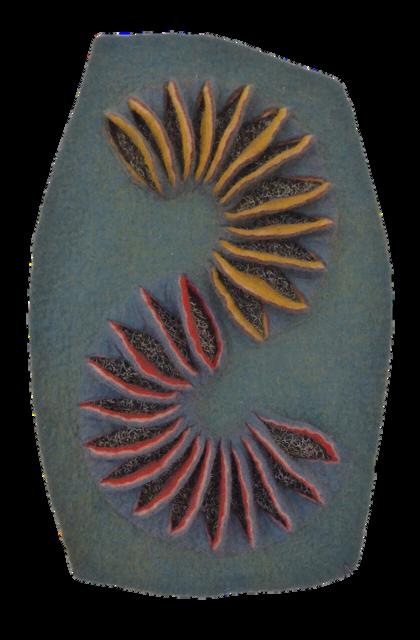
Clockwise from above: Twist and Turn. Reflections. 23 x 24cm. 3D relief on flat felt. £120.
Comforter brooch. 9 x 7.5 x 8cm. £75.


Twist and Turn. Spiral. 32 x 33cm. 3D relief on flat felt. £165.
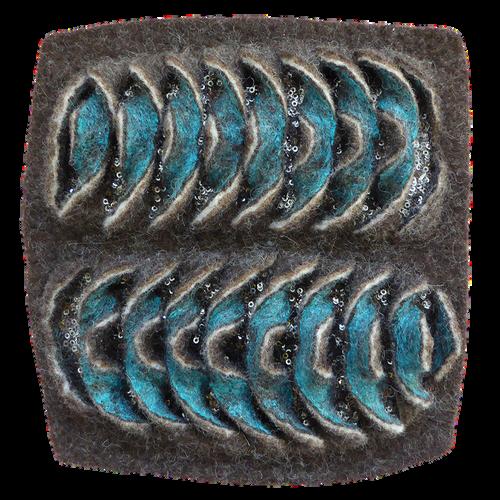
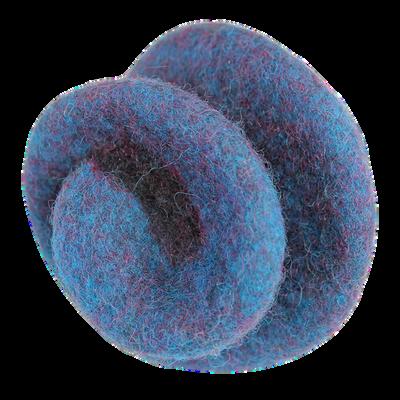
Bramley Rocking Chair
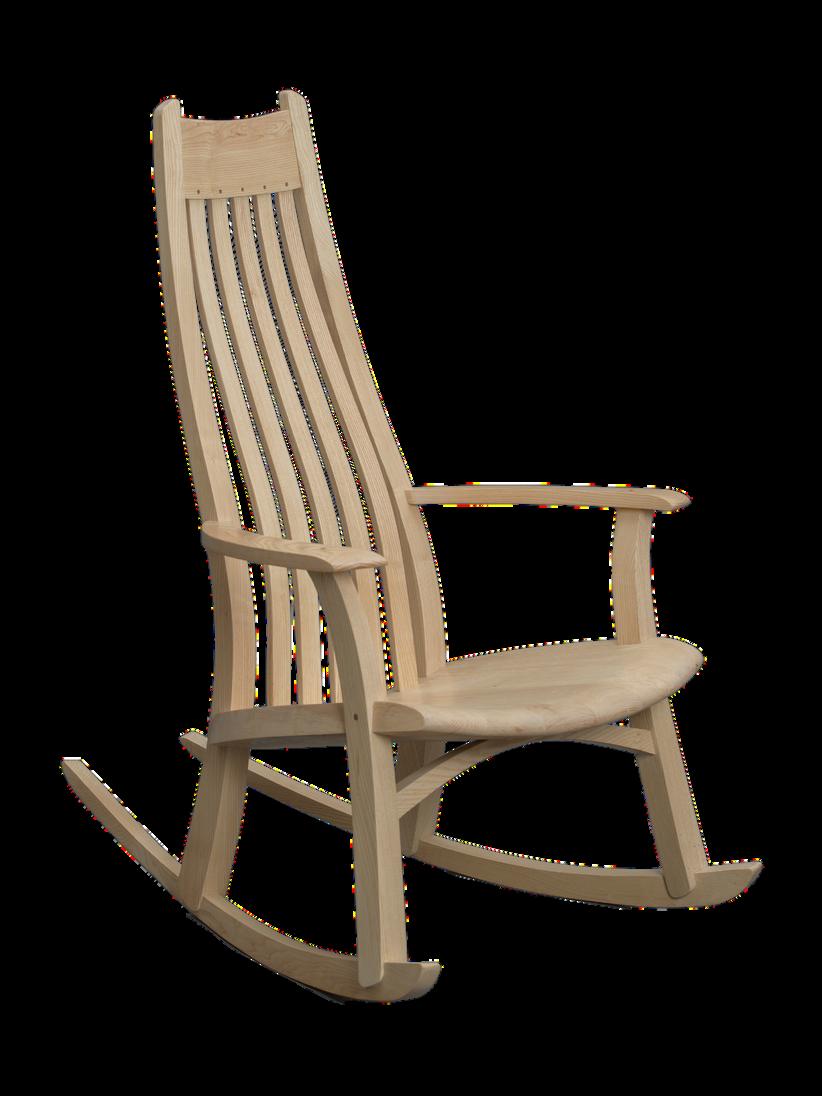
97 x 67 x 105cm £2950
Mark Ripley is a furniture maker whose work has been influenced by the tradition of English vernacular furniture and has evolved through a wide range of commissioned and speculative work for private clients and public spaces After gaining an Hons degree in 3D Design specialising in furniture, he established his workshop in 1986 and has been a full-time maker since 1991, apart from a short period teaching. His practice is focused on chair making and small commissions.
Mark is increasingly sourcing home grown timbers for his work, such as ash, oak, elm and chestnut. This series of chairs has developed out of many years of chair-making and are resolving into established signature designs. The processes are predominantly hand-made rather than batch produced using machine processes. They are available to commission singly or, in the case of the Lake and Morton, in short runs

From left: Morton Chair. 49 x 46 x 106cm. £1100.
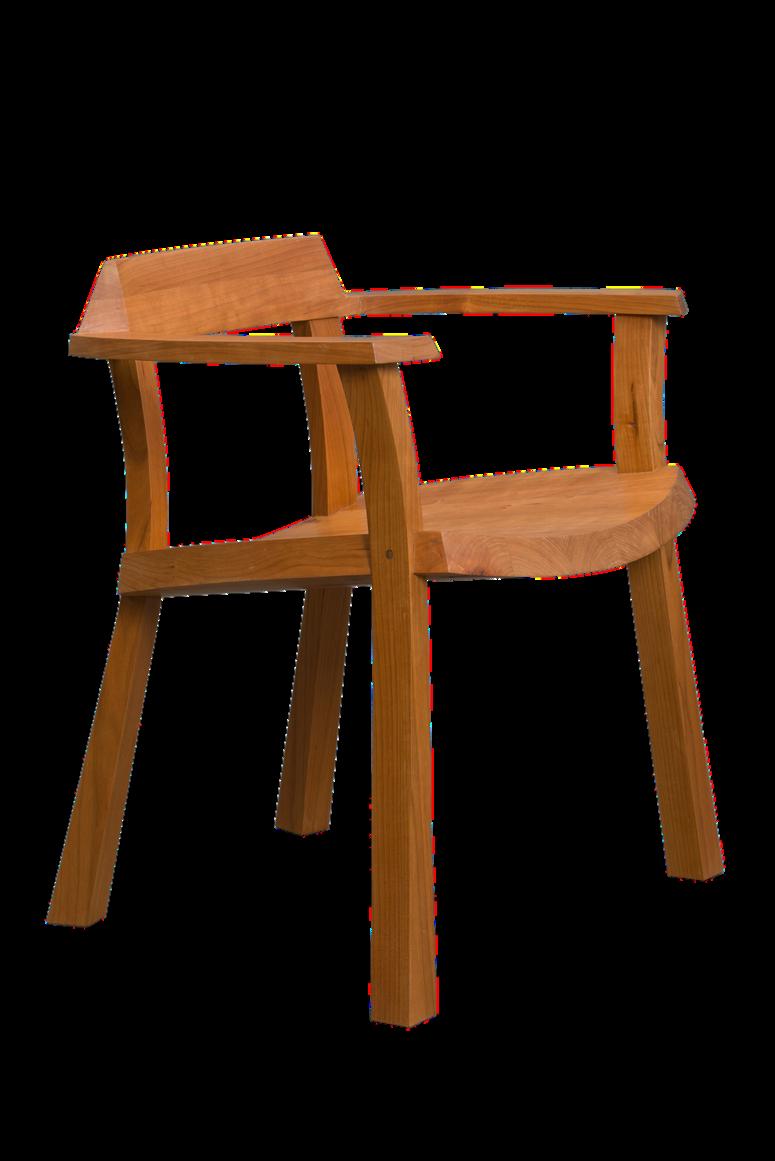

Bramley Rocking Chair (detail). 97 x 67 x 105cm. £2950.
Lake Captain’s Chair. 63 x 50 x 70cm. £2200.

Nici Ruggiero's work falls into two distinct categories, both of which draw from a monochromatic pallet. The first is characterised by large, indoor sculptural pieces of resist raku, embodying an aesthetic consideration for balance, form and beauty. The second comprises larger-scale conceptual, site-specific works supported by Arts Council England awards, formed of intimate installations of porcelain pieces, generally exhibited outside in multiple numbers.
'Abracadabra Hare' is a series of 21 slip-cast porcelain hares Pure white and essentially unglazed apart from their glossy gold ear-tips, their matt bodies are almost identical Each hare is swathed in strands of cashmere and silk wrapped around their necks. A triangular amulet swings from these strands, drawing the viewer to identify the words each bears. Here, the text “ABRACADABRA” is repeated in pyramid form, decreasing by one letter on each row, and ultimately diminishing at the lowest point on the triangular amulet
Research into the origin of the word 'abracadabra' unearthed its use as early as the Roman Period as an incantation against illness. It was inscribed and repeated multiple times on triangular amulets prescribed by practitioners as protection against disease. Although repeated, ABRACADABRA decreased on each line by one letter, and it was believed that as the word diminished, so would any illness
 Abracadabra Hare
Abracadabra Hare
Abracadabra Hare. 20 X 11 x 19.5cm. 21 hares, porcelain, gold lustre, cashmere and silk strands. Machined slate plinths. £275 each piece.
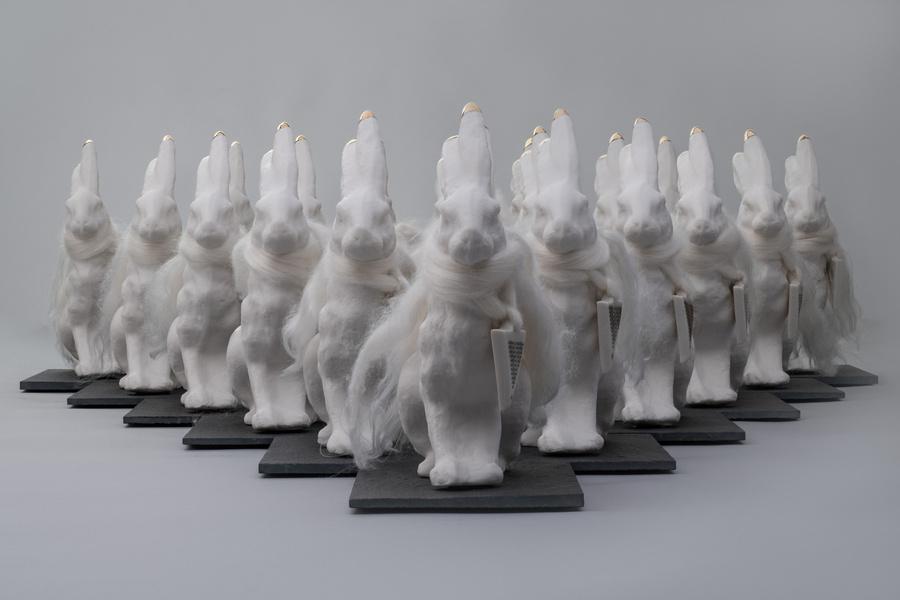

Triangular amulet, text “ABRACADABRA” repeated in pyramid form, decreasing by one letter on each row, and ultimately diminishing at the lowest point on the triangular amulet.
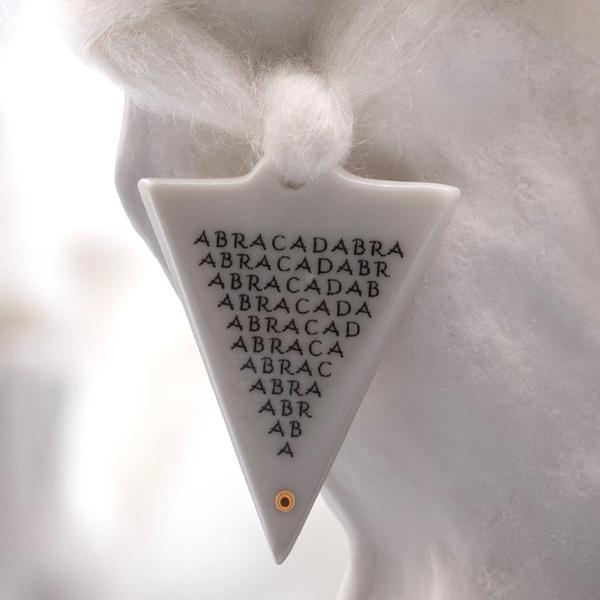

Ocean Shawl (detail)
171 x 44 x 26cm (on mannequin). Felt, merino wool, silk and plant fibres hand dyed with Saxon Blue natural dye. £445
Moira Searle is a felt artist specialising in one-off wearable art items of women’s clothing. Each piece is individually fashioned using a blend of wool as a base. The felting process enables other silk and plant fibres - as well as recycled vintage fabrics - to be incorporated, creating textural interest and contrast “I am filled with wonder by the amazing textural contrasts of the coastline and beautiful qualities of wool and silks that I use,” she explains
'Ocean Shawl' – a warm and stylish piece of wearable art - is inspired by the myriad colours of the ocean, in particular those that dance around on the sea’s surface; and it also draws on the texture created when waves hit the shore and mingle with the sand and pebbles found there
In her jacket piece 'Miss Havisham visits the Seaside', Moira continues to ponder on her muse Miss Haversham (a character from the Dickens' novel Great Expectations), by wondering what life she would have led as an independent woman






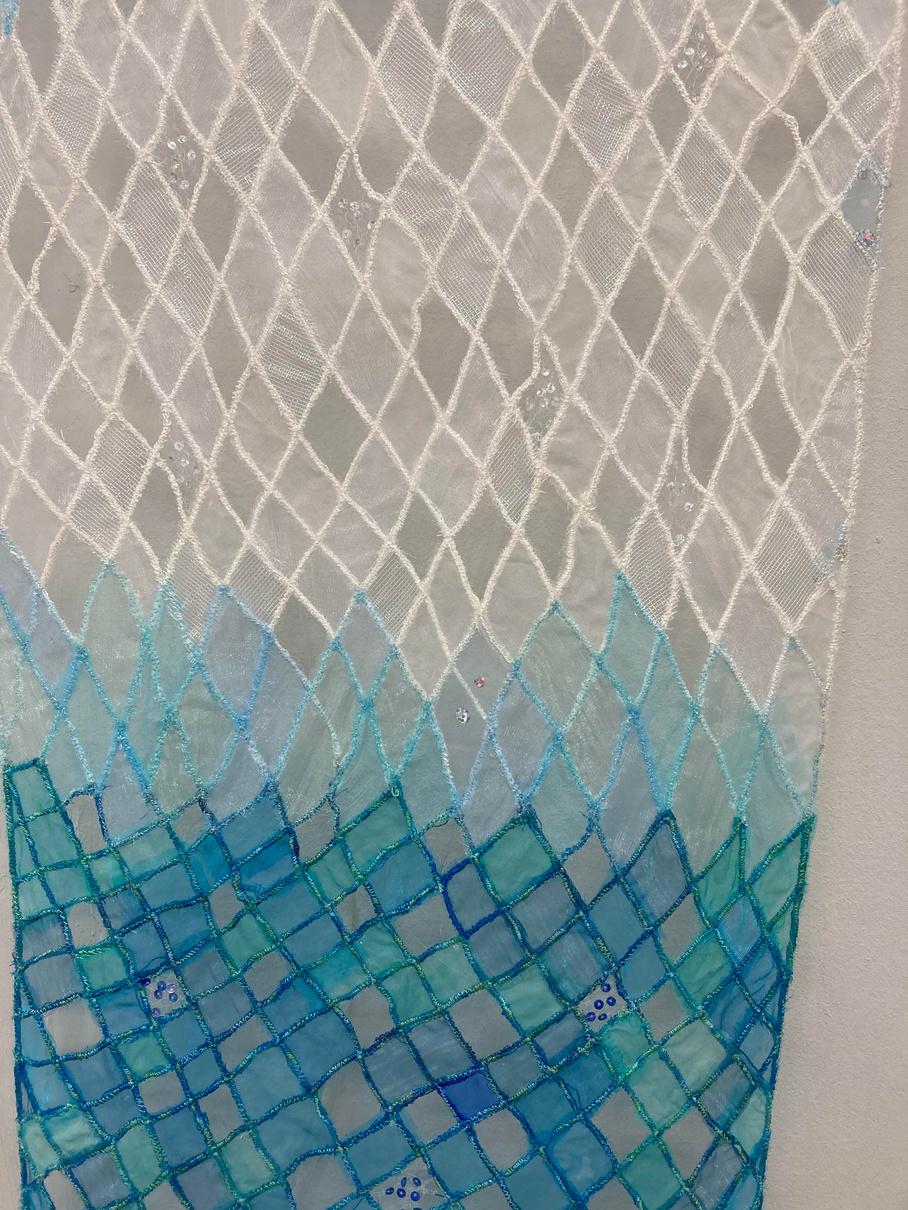
85 x 30 x 2cm Free-machine embroidery, soluble ground with added sheer fabrics £895
Arlene Shawcross is a textile artist specialising in free-machine embroidery. Her work is diverse; ranging from wall pieces to lace garments, the latter created by stitching on to a dissolvable base, which, once gone, leaves a delicate filigree material She has also perfected the art of layering and stitching fabrics to create rich, intricate textures
Her work for the exhibition draws heavily on a trip to Antarctica earlier this year. The “wondrous beauty of the landscape there, particularly Paradise Bay, ” she says, “excited and inspired me ” Deeply influential for Arlene’s work was the pure blue of the Antarctic sky and ocean, the latter intensified by the former; and the luminous blue of snow melt waters contrasting against the dazzling white mountain snow under the blazing southern hemisphere sun.

Left: Antarctica (detail). 50 x 55 x 5cm. Continuous free-machine embroidered cord stitched onto a soluble ground. The colours of the cord go through subtle changes to reflect the colours in the Antarctic landscape. When the stitching is complete the background is dissolved away. £595.

Paradise Bay. 50 x 55 x 5cm. Stitched impression of Paradise Bay using layers of applied fabrics, some of which have been cut back and stitched using freemachine embroidery. £395.
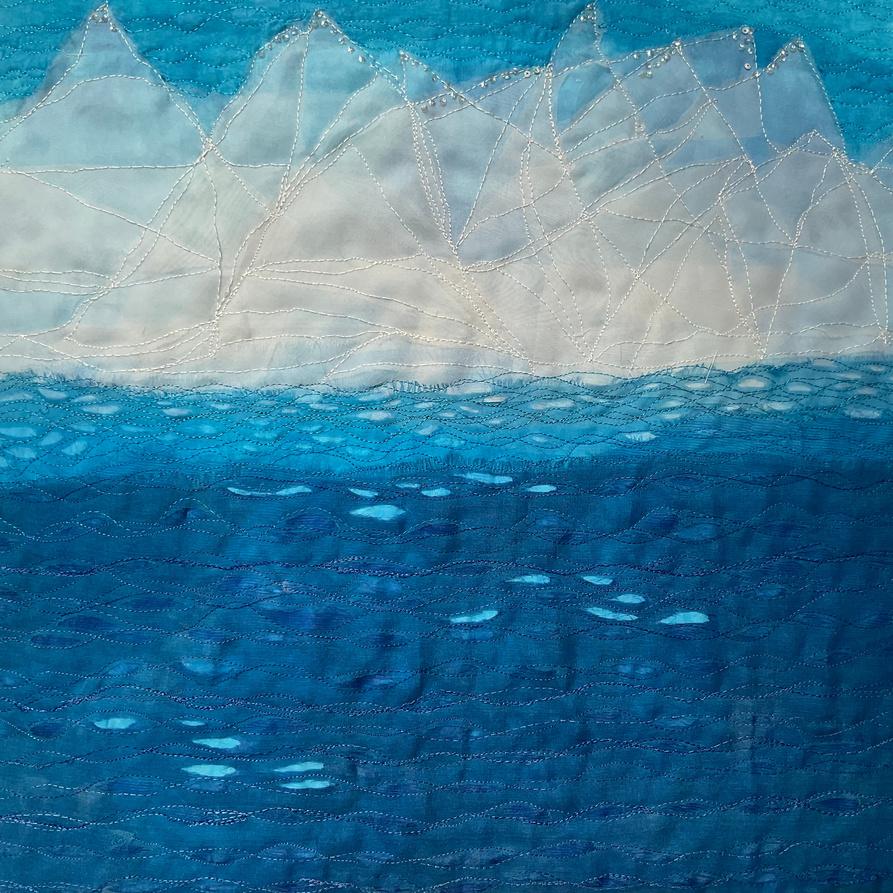
95 x 95 x 5cm Textiles, hand painted with colour pencils and Farsi inscription £4200
Batool Showghi’s multidisciplinary approach to the artists’ book and her mixed media work involve photography, illustration, painting, and textiles. All of which are employed to explore themes of cultural heritage, memory, identity, and loss in very personal ways. Her work as an artist is concerned with the experience of women and the way in which this experience relates to cultural and religious boundaries as well as reflecting on the theme of turbulence, immigration, disintegration of the family and the experience of displacement
In recent projects Batool uses textile pieces on canvas and paper and the use of a sewing machine as a drawing tool to create her imagery. 'The Rise of Women' is a textile piece on canvas, hand painted with colour pencils and Farsi inscription The writing in Farsi is a poetic reflection on her memories, the environment she grew in, the family and a city which was lost during the war. These visual autobiographical artworks are designed to narrate and show the beauty and sadness of this struggle which will always be there.
A series of her artist’s books and mixed media works are in permanent collections of: The Tate Britain, British Library, The Royal Navy Museum in Portsmouth, the Museum of Art and Literature, Yerevan, Armenia, and in many libraries and private collections.


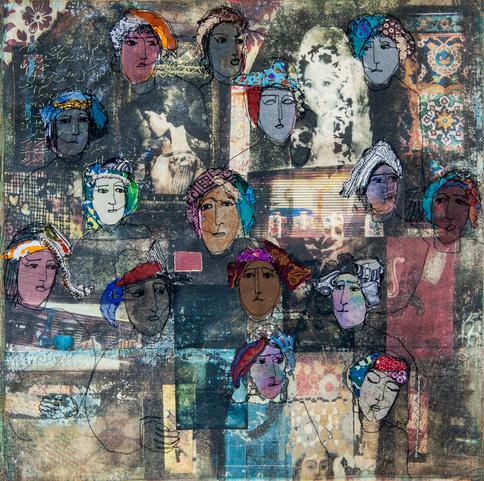
Above: Hear Our Voices. 2023. 43 x 43 x 5cm. Textile and transferred imagery on Cloth. £1100.
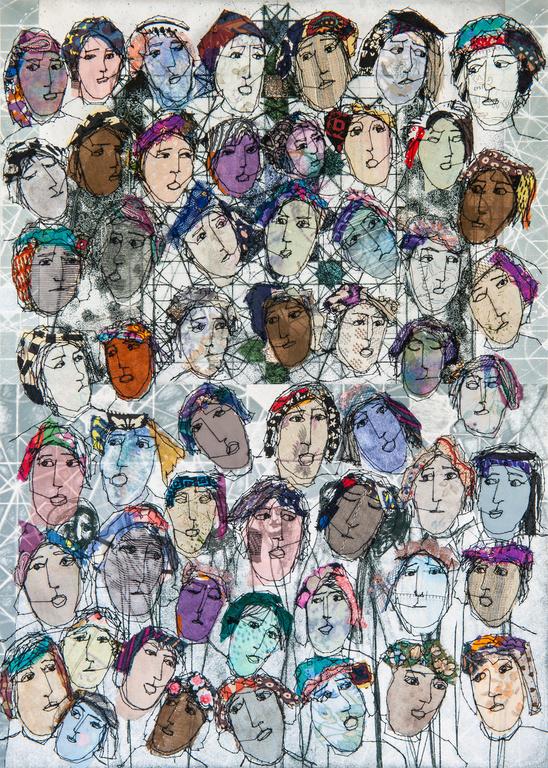
Displaced 2022. 36 x 48 x 3cm. Textile on printed imagery, on paper. £1000.

2.8 x 3.6 x 1.3cm. Chopped up brass shell casing, ebony offcuts, sterling silver and stainless steel pin. £450

Emily Smith is a designer-maker with an exploratory spirit. She experiments with different metals and techniques to craft wearable and decorative objects Gathering inspiration from an amalgam of ideas intertwined with humanity, her current work revolves around taking something with negative connotations and turning it into something positive. Her hope is to encourage people to look into their own lives introspectively, and begin acquiring knowledge and seeking opportunities in which they can do better by other people - and themselvesalongside her, as she tries to do the same
The pieces exhibited in WONDER are from Emily's 'Make Jewellery Not War’ collection. Each piece has its own little theme and inspiration; whether it be a celebration of people power, possibility, or a kind gesture shared She started this collection in 2015 with a strong desire to ‘do something’ after news emerged of Syrians being forcibly displaced At the beginning of 2020, the collection found a new lease of life, motivated by an overwhelming compulsion and a large array of different social issues. Emily produced a collection of little wearable sculptures that serve as a reminder to not only see the good in as much as possible, but also to be it The little people are modelled and cast in brass taken from chopped up cartridge casings The use of such a warm coloured, shiny metal aims to give them an appearance of a little beacon of light. 10% of sales go to Medecins Sans Frontieres.
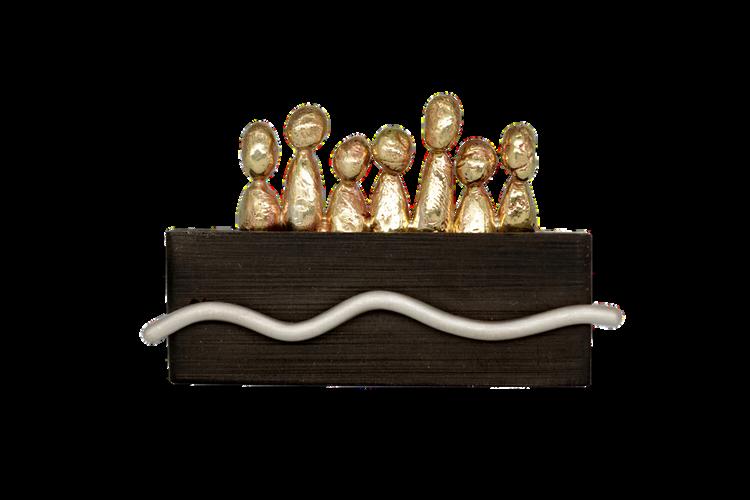
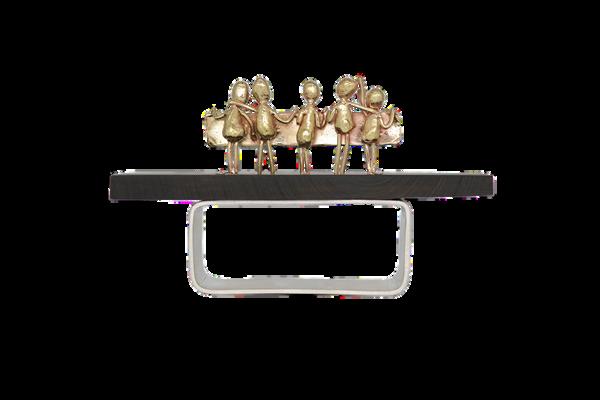
Clockwise from above: Journey Ring. 89 x 20 x 62mm. Ring size T. Chopped up brass shell casing, ebony offcuts and sterling silver. £800.
Journey II Brooch. 50 x 13 x 31mm. Pin length 38mm. Chopped up brass shell casing, ebony offcuts, sterling silver and stainless steel pin. £600.


Patching Up Humanity Ring. 38 x 25 x 50mm. Chopped up brass shell casing, ebony offcuts and sterling silver. This piece has a little removable display attachment to allow it to stand up by itself. £900.
Voice Ring (back and front). 89 x 20 x 50mm. Chopped up brass shell casing, ebony offcuts and sterling silver. £850.
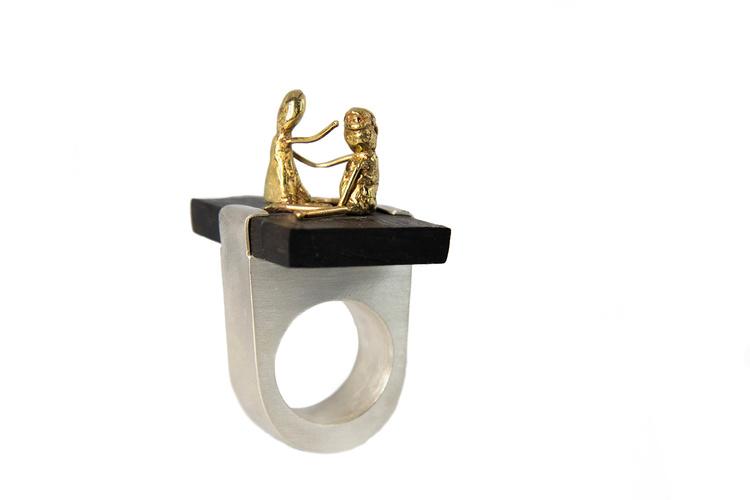


30 x 5cm. Sycamore, hand turned on the lathe, pierced and stippled. £400
Patricia Spero and Gabor Lacko have always been fascinated and inspired by the textural hidden depths and colours of wood, aiming to bring out the inner patterns and shapes of the substance and enhance them with their own designs. Inspired also by nature, using the colours and shapes of leaves and flowers throughout the seasons, their work expresses the beauty of the natural world
Designed to be held as well as viewed, their pieces offer a tactile and meditative expression of the wonder of nature and bring a feeling of calm and relaxation.
Using only sustainable English woods, mainly maple and sycamore, these are turned very thinly on the lathe prior to being pierced and hand cut into their designed pattern and then coloured by airbrushing.

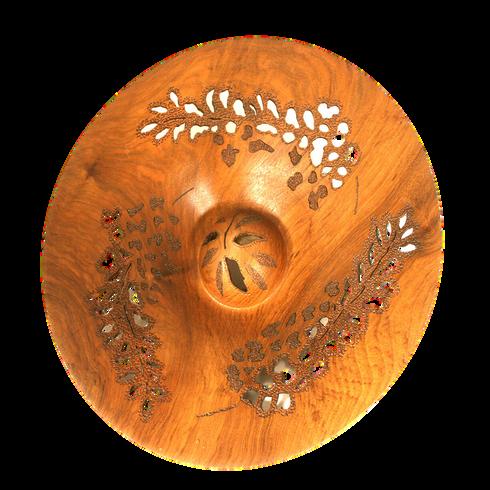

Autumn Leaves. 20 x 27cm. Maple. Hand turned on the lathe, carved, pierced, stippled and coloured. £2000.
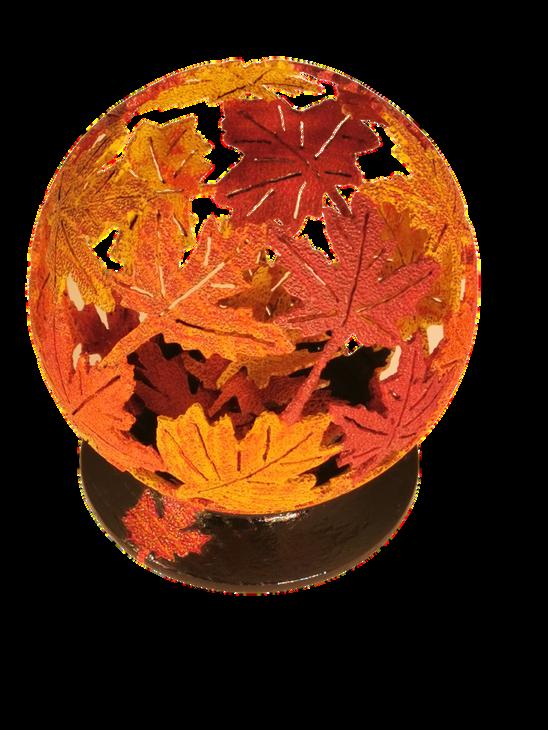
Forest. 19 x 20cm. Sycamore, hollow form, carved and pierced. £200.
Green Wisteria. 24 x 4cm. Maple, hand . on the lathe, pierced, stippled and coloured. £350

Dark Wisteria. 29 x 6cm. Walnut, hand turned on the lathe, pierced and stippled. £350
Peach Blossom. 16 x 4cm. Maple, hand turned on the lathe, pierced, stippled and coloured. £350
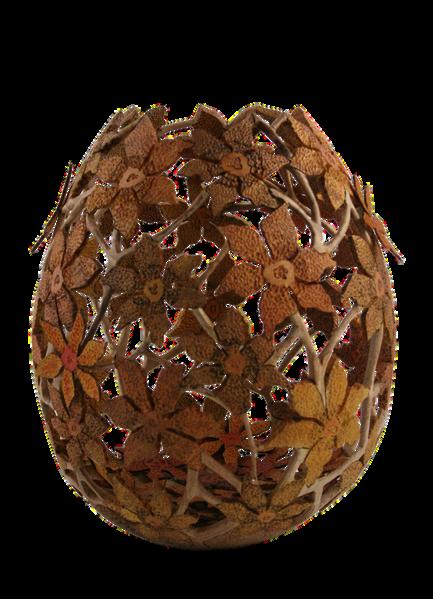
 Clockwise from above: St Paul's Bell. 19 x 20cm. Sycamore, walnut and artificial ivory. Hand turned on the lathe, pierced and stippled. £600.
Clockwise from above: St Paul's Bell. 19 x 20cm. Sycamore, walnut and artificial ivory. Hand turned on the lathe, pierced and stippled. £600.
Dee Thomas is a contemporary textile artist with a love of colour and texture. Working from her drawings she translates her observations by patching and layering fabrics to form a background on which to stitch. Her workroom is packed with colourful materials salvaged from charity shops or donations from friends from which she selects the small pieces used in her work This style of working reflects her interest in collage
The pieces of work for WONDER evolved from looking at maps, landscapes, and views of the countryside near her home in Hampshire. The view from the top of a hill showed the patterns formed in the landscape by pathways, planting and natural forms Crops coloured the fields but details were lost from a distance and the tracks divided up the views Symbols from maps replaced lost details.


Clockwise from above: View from country market with houses. 20 x 20cm in a 30 x 30cm frame. Naïve style embroidery featuring houses. £175.
View from country market with houses (detail).
View from country market with barn (detail) 20 x 20cm in a 30 x 30cm frame. Naïve style embroidery featuring barn. £175.


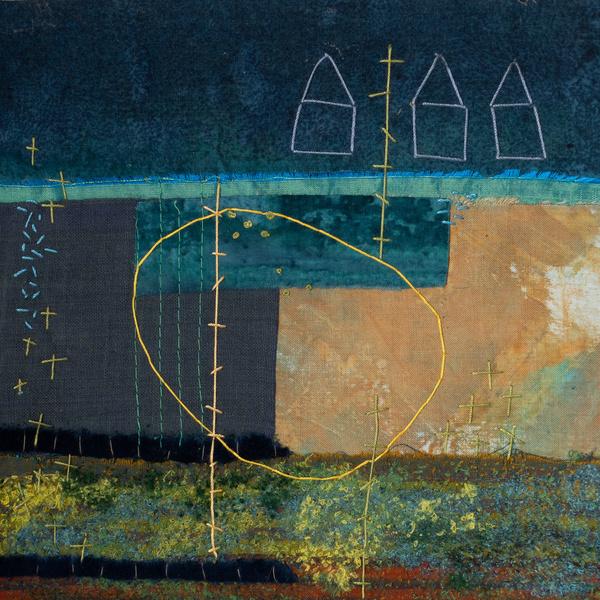
27 x 11 x 36cm. Cast glass. £2200
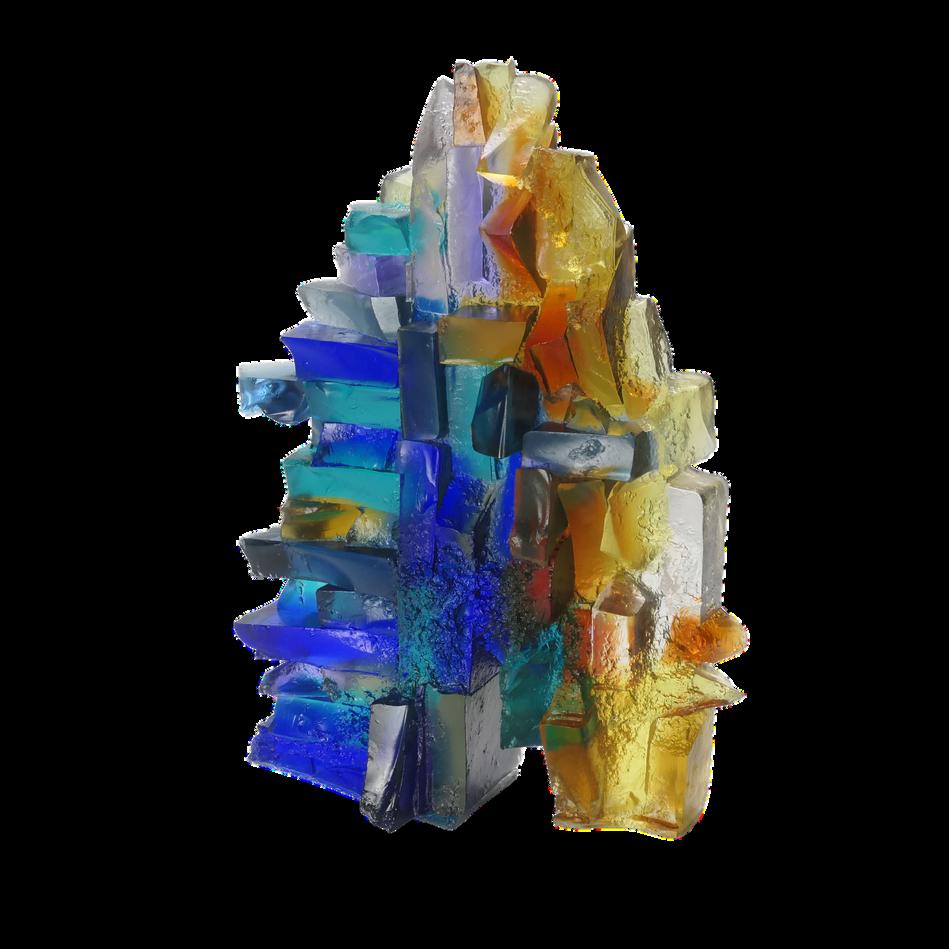
Deborah Timperley has been creating with glass for over 25 years, exhibiting in Germany, Belgium, Switzerland and Lithuania as well as prestigious exhibitions in the UK such as the British Glass Biennale Her work is mostly sculptural exploring a variety of themes including 'Rocky' sculptures based on the landscape The 'Dialogue at the threshold' series focusses on the liminal area between the inside and outside of a form and draws references from Islamic architecture. Her series on 'Memory and Alzheimer’s' uses the metaphor of Faberge eggs to celebrate the creativity of the well brain paired with contrasting pieces illustrating the loss of all that we are when lose our mind
The series of rocky sculptures being exhibited at WONDER, explore the beauty of harbour walls, dry stone walling, rocky outcrops and rock pools. The compositions are evocative of the landscape and suggest rocks and stones placed harmoniously together, contrasting defined edges with the softness of adjacent vegetation The blocks of colour echo the surrounding landscape and sky They have a sense of place and atmosphere
Clockwise from top: Rocky outcrop in aqua, grey and clear glass. 32 x 14 x 13cm. Cast glass. £980.



Rocky outcrop fired with 23.5ct gold lichen and engraved with meadow grasses. 16 x 4 x 8cm. Cast glass. £185.
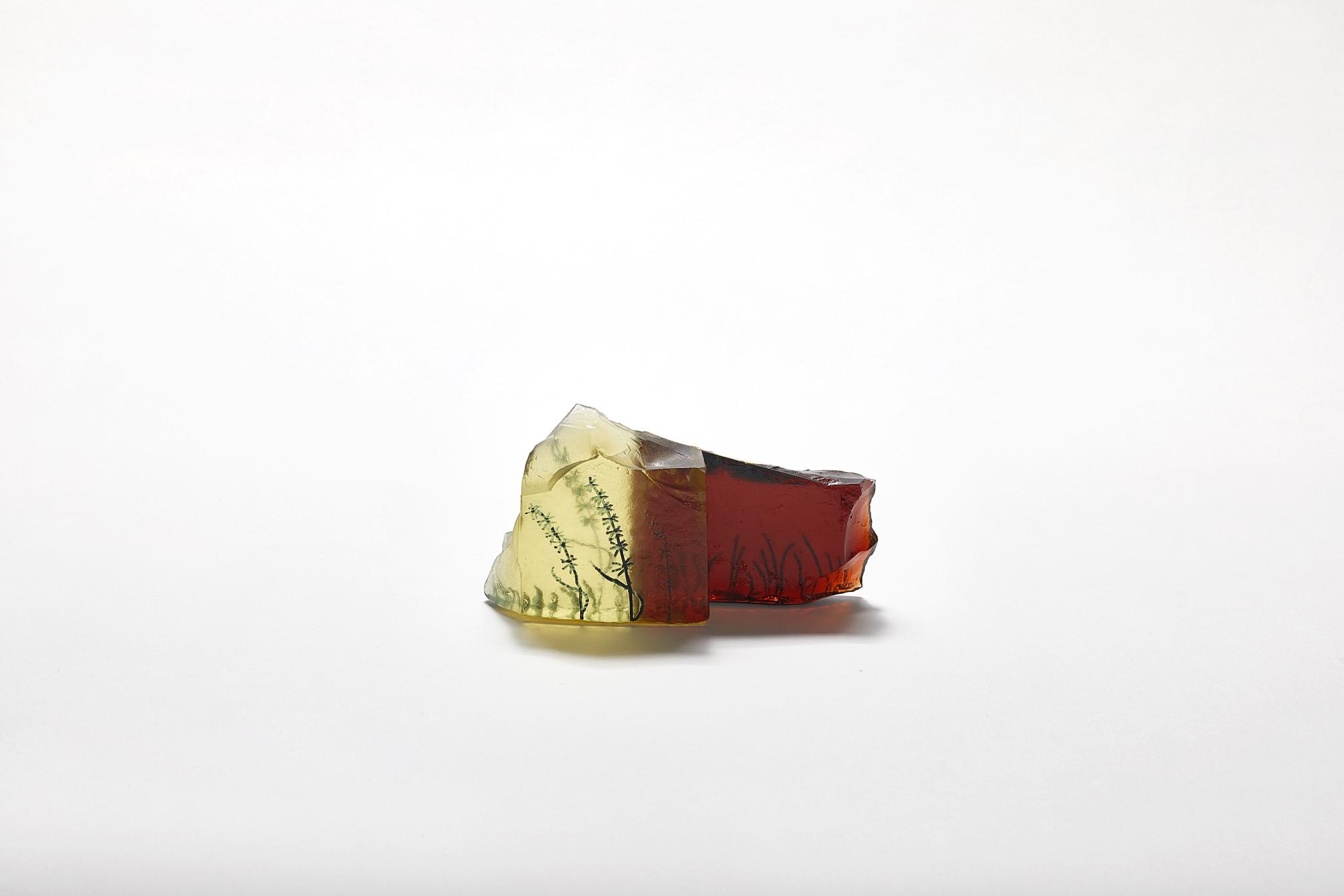
Rock Pool. 18 x 20 x 20cm. Cast glass. £1150.
Rocky outcrop in ambers and clear glass. 13 x 7 x 7cm. Cast glass. £95.
Stepped bridge over water. 14 x 10 x 10cm. Cast glass. £225.

Ali Tomlin has always drawn, designed and painted and loves the energy of random lines or marks, from a sketch, painting or just found She enjoys how just a simple line or mark can completely change the feeling of a piece.
Ali's work is a collection of thrown, uncluttered porcelain forms. She uses stains, oxides and slips, sponging and scraping colours and inlaying lines, working both on the wheel to capture a feeling of movement and using various, evolving monoprinting and mark making techniques. Surfaces are unglazed, with a soft, matt surface.
Inspiration comes from found marks and contemporary art and is also heavily influenced by her graphic design background. She leaves much of the surface clear as a consistent device, to allow the use of many different colors and marks, yet keeping all of the work looking from the same family.

Clockwise from above: 22cm. Cylinder, black lines. Matt surface, glazed inside. £180.
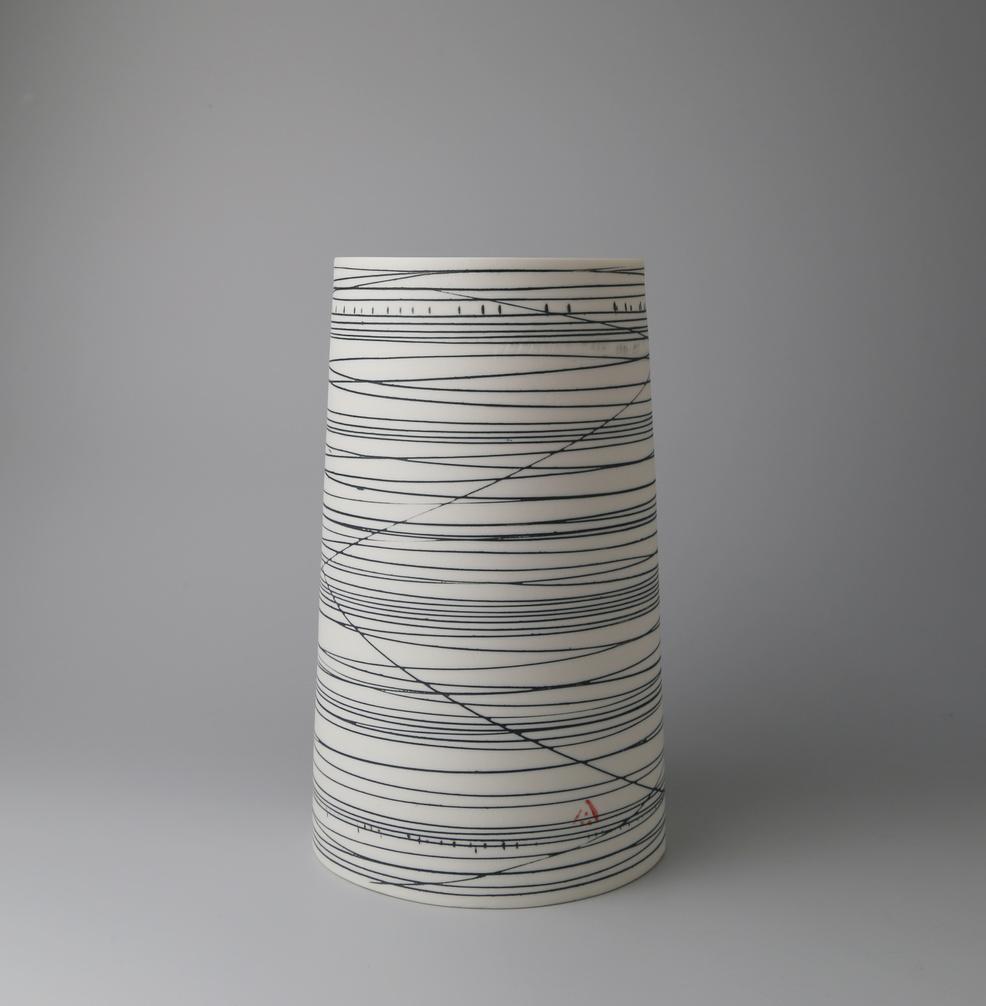
Light. Bell shape, green & grey splash. 24cm. £350.
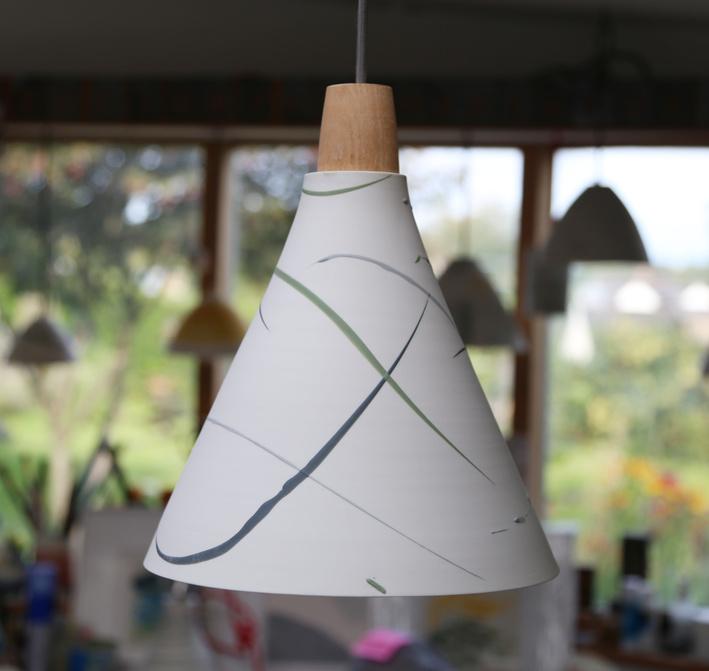
Light. Large conical, two blues. 22cm. £210.
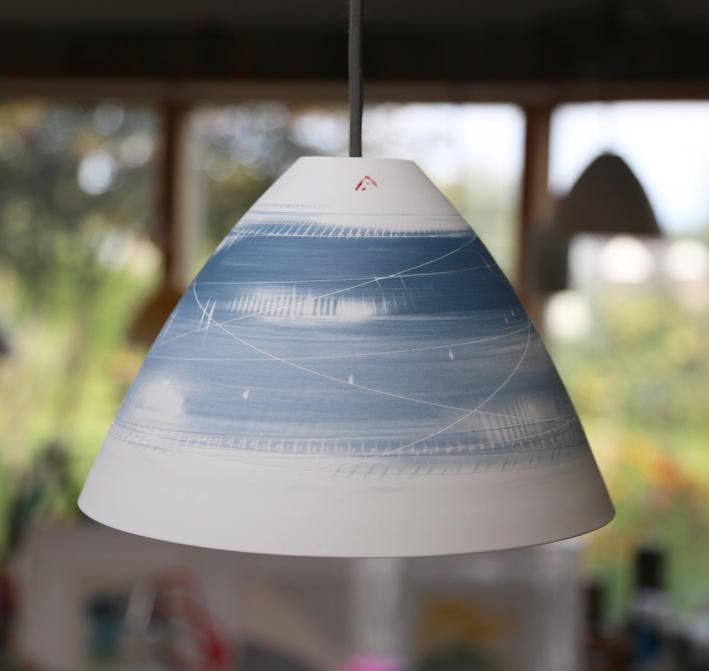

Light. Large conical, blue lines. 22cm. £210.

Susannah Weiland is a hand embroidery artist inspired by the natural world. She works in two different styles, figurative and abstract. Her figurative work combines tonal pencil drawing with hand embroidery stitching using machine embroidery threads. She is a keen photographer and often work from her own images. She pencil draws and then meticulously hand embroiders all of her designs: no two pieces are the same, making them one-off collectables.
The four pieces of work being exhibited in WONDER represent some of the wildlife that can be found in the Royal London Parks. Each of these started off as a monochrome pencil drawing which she hand stitched colour and texture into
 Greenwich Jackdaw
Greenwich Jackdaw

Clockwise from top left: Hyde Swan. 37 x 2.5 x 38cm. Tonal drawing, hand stitching with silk, matt and metallic machine embroidery threads. £3000.

Hyde Bunny. 32 x 2.5 x 34cm. Tonal drawing, hand stitching with silk, matt and metallic machine embroidery threads. £2800.
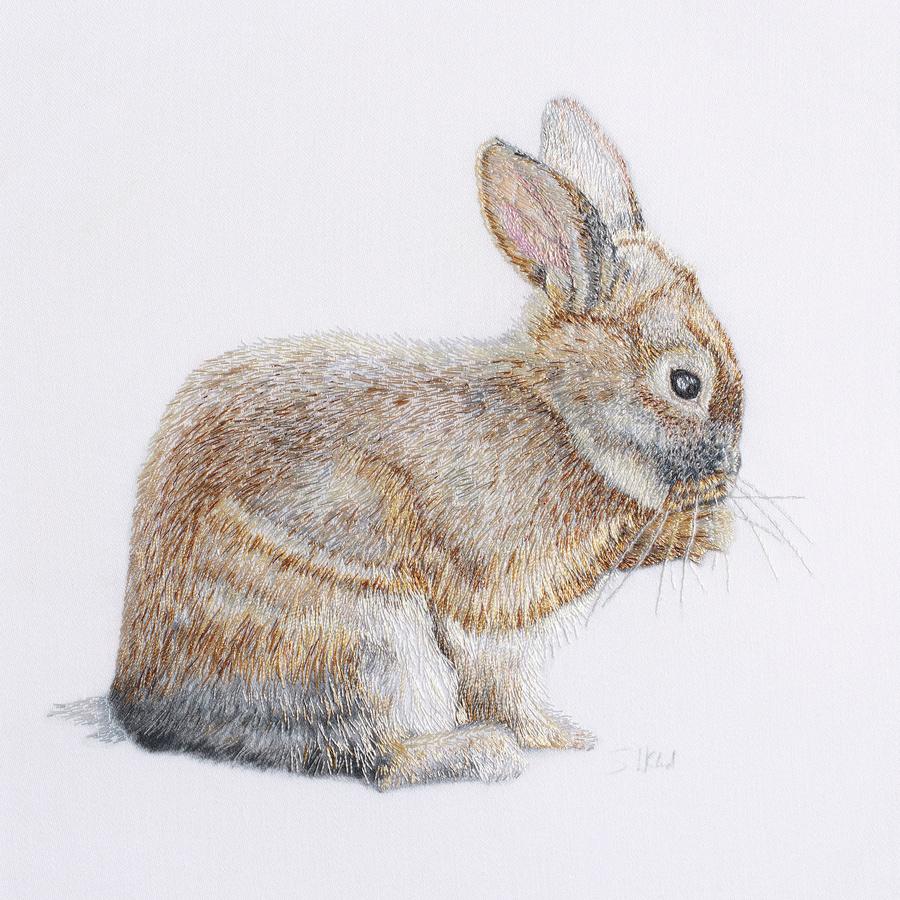
Regent Hedgehog. 30 x 2.5 x 27cm. Tonal drawing, hand stitching with silk, matt and metallic machine embroidery threads. £2200.

Elm Tree
4 5 x 5cm Silver brooch/pendant 18ct detail with landscape agate £399
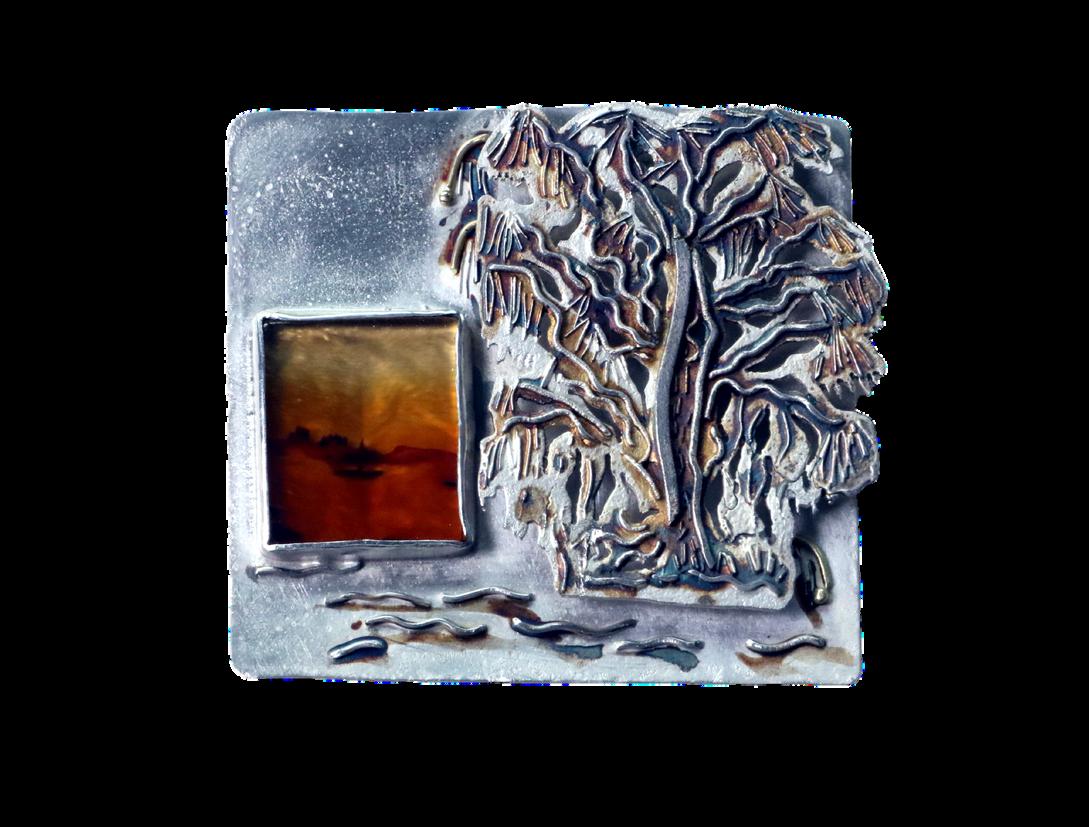
Michele trained at Birmingham Jewellery School and works in precious metals along with many types of minerals and gemstones. Based at her studio in Birmingham's well-known jewellery quarter, most of her work is completely handmade She likes to push the boundaries as far as design and materials are concerned to make original pieces which will become valued heirlooms.
Michele is inspired by the natural world. For example, working from photographs, usually her own, the pieces in her Tree range are based on real trees But in addition, the landscape of the final design is influenced by the natural markings within the individual gemstones she is choosing to work with. Over the years her designs have become more complex and intricate.

Clockwise from top left: Cedar Tree. Silver brooch/pendant. 4.5 x 5cm. 18ct detail with landscape agate. £399.
Cubed Trunk Fish Brooch. 2.5 x 6cm. Handmade silver with labradorite and 18ct gold detail. £250.
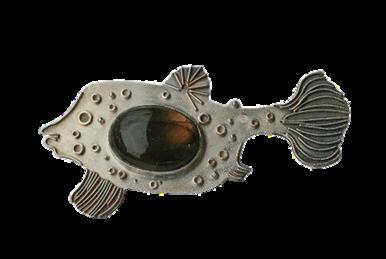
Wrasse Brooch. 2 x 7.5cm. Handmade silver with labradorite and 18ct gold. £250.
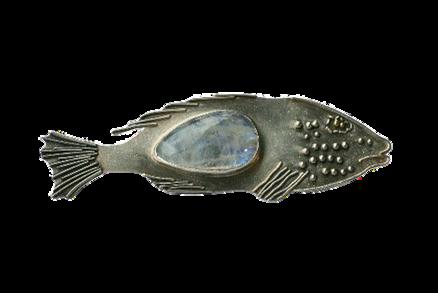
Alder Tree. Silver brooch/pendant. 3.5 x 4.5cm. 18ct detail with landscape agate. £399.

Lunartail Grouper. 2.5 x 6cm. Silver with petersite and 18ct gold detail. £250.

Ash Tree. Silver brooch/pendant. 4.5 x 5cm. 18ct detail with landscape agate. £399.
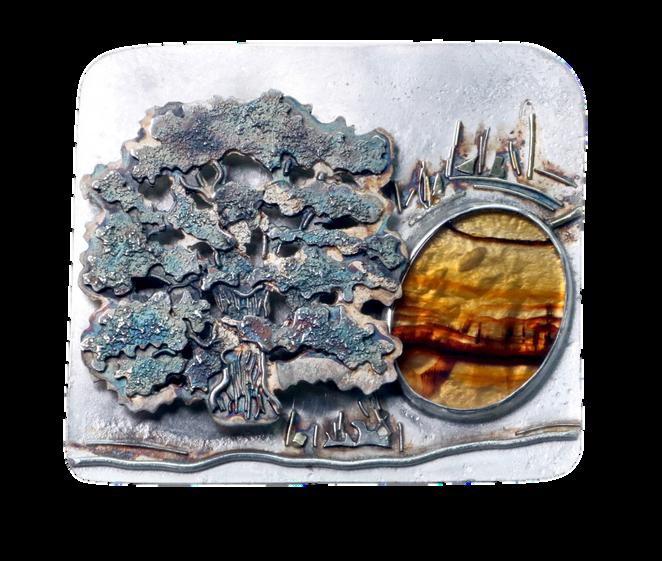
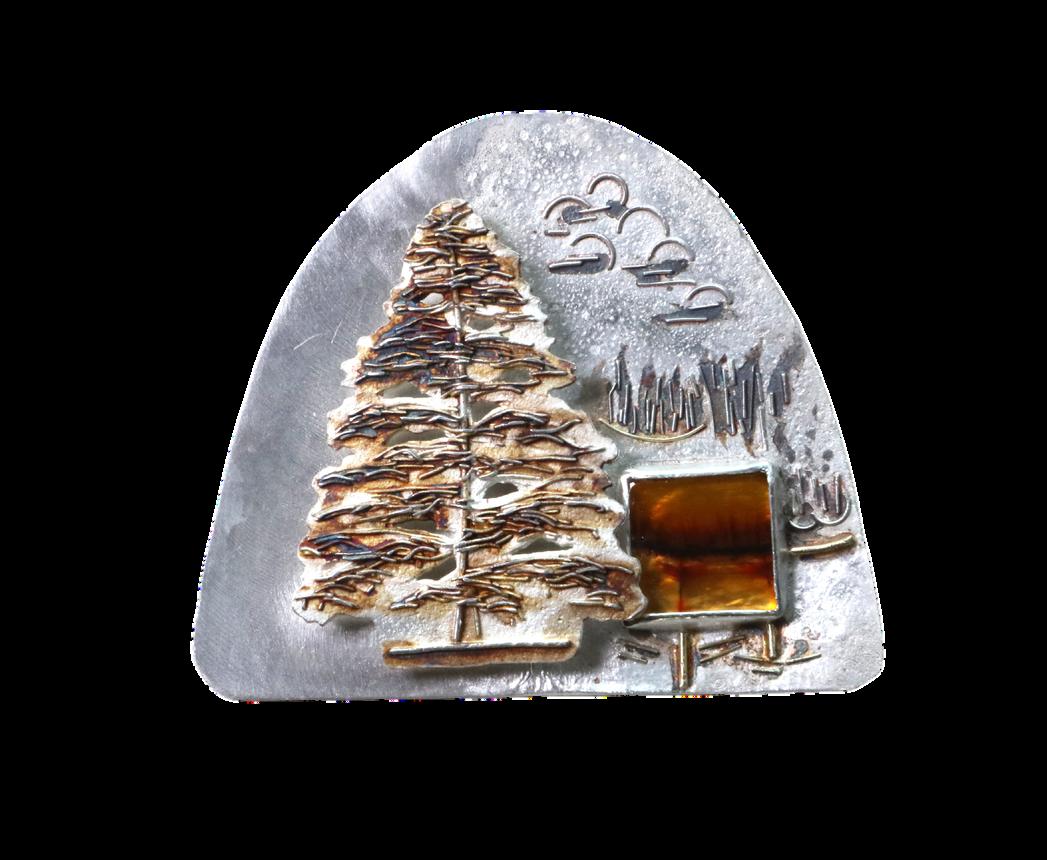
The Golden Orb Side Table 45 x 45 x 80cm American Black Walnut with a planished gilded top £4250
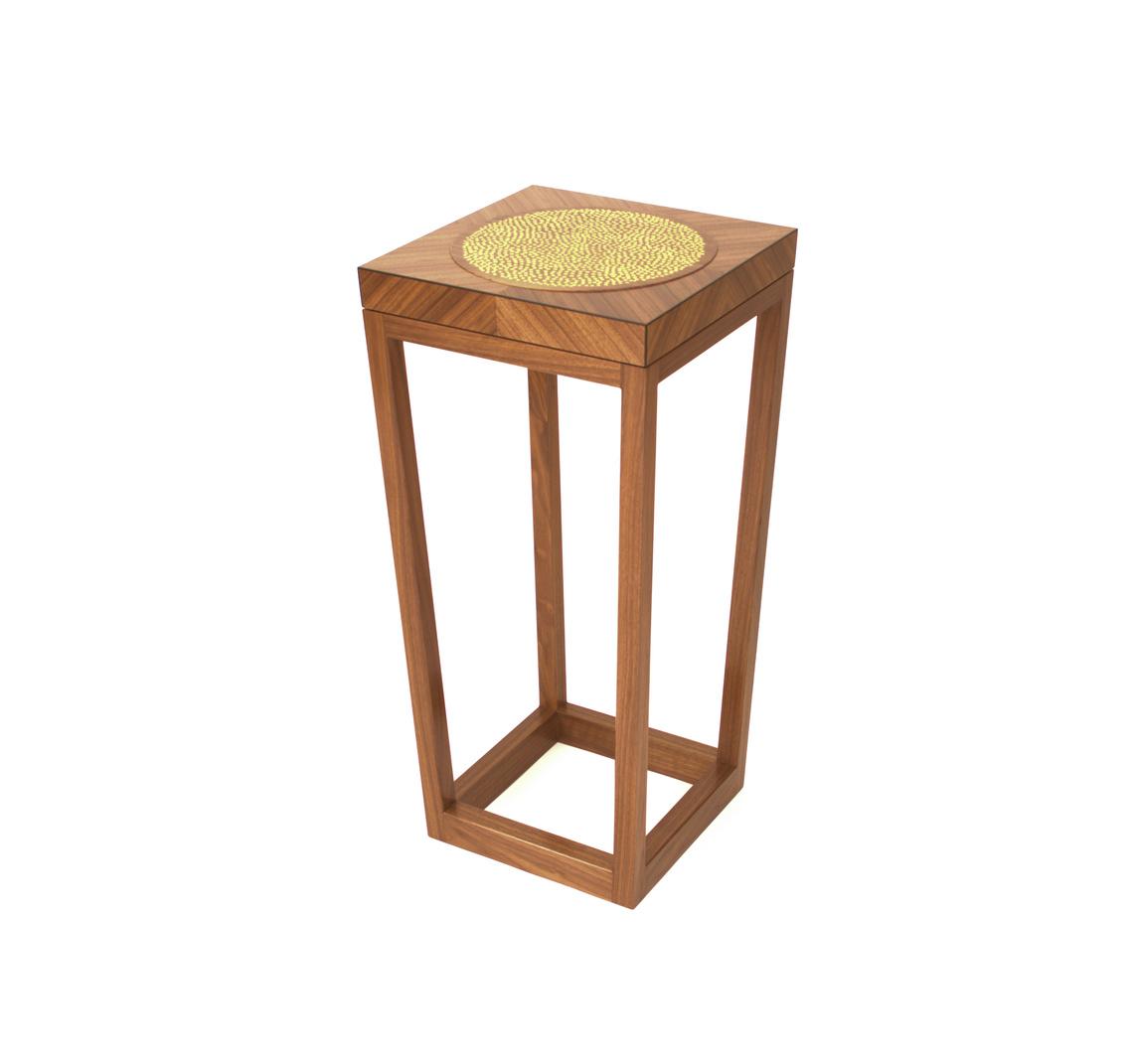
Edward Wild is an award-winning furniture designer-maker, creating handmade bespoke furniture in an elegant contemporary style, combining the finest materials together with his skilled craftsmanship The sensitive combination of classical design with a commitment to exquisite craftsmanship, enables Edward to create pieces which enrich their surroundings and see clients returning time and again. Ranging from luxury jewellery and cufflink boxes to elegant dining, lounge and bedroom furniture, each piece is a celebration of bespoke design and hand craftsmanship. All Edward’s work is created by hand in his workshop, including limited edition pieces and bespoke commissions
The Golden Orb Side table is made from American Black Walnut with a dramatic gilded top. The tapered sides of the table lead up to an elegant top which has a herringbone pattern radiating out from the centre and running down the sides. The table top floats above the table frame with a slender shadow gap, and is detailed with dark ancient black Oak on each corner. A golden gilded disc with a complex hand beaten surface is set into the top of the table completing this stunning piece.
Clockwise from top: The Burr Walnut Burnett Table. 43 x 73cm. The Burnett occasional table is hand-crafted from American Black Walnut with ancient bog Oak accents. £2750.
The Golden Orb side Table. Details of planished gilded top. £4250


The Burr Elm Hall Table. 120 x 73 x 45cm. This handmade table showcases a combination of burr Elm and ornamental Maple, resulting in a sleek and contemporary aesthetic. £5350.
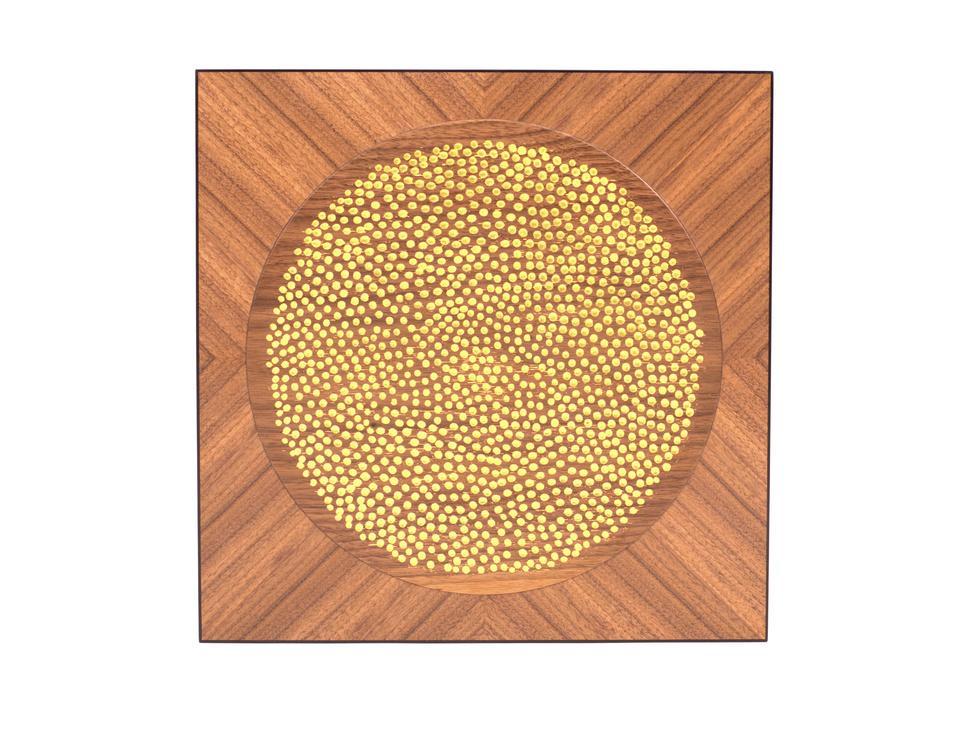

29 x 26cm. White earthenware jug, rolled handles, coloured with stained slip. £140
Mignon has been a professional ceramicist for over 40 years. She has exhibited her work in many galleries including the Circle Gallery, Glasgow and the Drawing Barn, Marlborough and been featured in Jane Waller’s seminal book on current ceramics practice, 'Colour in Clay'.
Working from her studio in Oxford, she makes hand built earthenware jugs inspired by nature, flowers, abstract natural forms and the work of William Morris
For the Wonder exhibition, Mignon is exhibiting a group of six jugs, all of same size and shape, but with variations of colour. The group is a musing on the elusive, dreamy and magical nature of a garden, with its jewel-like flowers and seedheads set against varying and textured vegetation

Dark Garden. 29 x 26cm. White earthenware jug made in a press mould with rolled handles and coloured with stained slip. £140.

Green Garden. 29 x 26cm. White earthenware jug made in a press mould with rolled handles and coloured with stained slip. £140.

Green Garden detail.

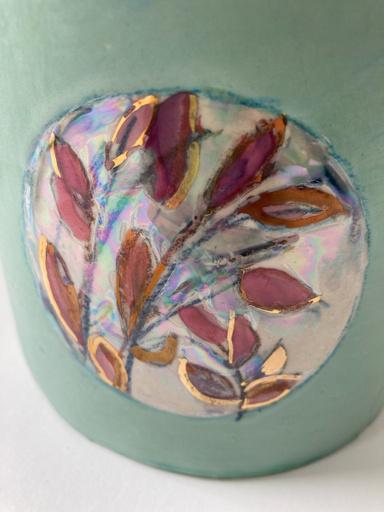
 Clockwise from top Blue Garden detail.
Clockwise from top Blue Garden detail.
Association with a heritage brand: The Society of Designer Craftsmen was originally formed as the Arts and Crafts Exhibition Society in 1887, with early president William Morris, The Arts and Crafts Movement was one of the most influential, profound and far-reaching design movements of modern times. Its pioneering spirit of reform, and the value it placed on the quality of materials and design, as well as life, shaped the world we live in today
Help emerging talent: We believe that investing in training and education is crucial to ensuring that essential craft skills are retained and nurtured for the future. The Society gives professional recognition and support at all stages of a maker's career, from Student through to Fellow In a challenging world, your support would help us nurture the next generation of emerging talent.
Wellbeing and making: The positive link between wellbeing and making has been well documented. Research shows that engaging with the visual arts can reduce reported anxiety, improve life satisfaction and can protect against dementia Our regular exhibition programme plus the many other shows our member participate in, across the UK and beyond, ensures such benefits are offered to a large and broad audience. Creative activity undertaken daily is also linked to positive psychological functioning. Investment in the Society helps us encourage craft-making and improve the lives and wellbeing of more people
Become a Patron: The invaluable support of our patrons, at all levels, helps the Society of Designer Craftsmen to support talented makers, promote craft to new audiences, and champion craft education. Patrons have the opportunity to attend bespoke events that bring them closer to the work of the Society of Designer Craftsmen, meeting makers and likeminded individuals
Become a Corporate Partner: Together we can build individually tailored campaigns, crafted to meet an organisation’s business objectives around brand awareness and engagement amongst our audiences We could also work collaboratively with you to offer our members’ in-depth knowledge and expertise over a range of crafts and related skills, for example the link between making and wellbeing.
Collaborations and Commissions: Many of our makers have carried out national and international commissions for private individuals, the public sector and corporate clients Why not commission one of our makers to create something completely bespoke and unique to your requirements?
Donors: This can include donations to support our student and mentoring programme, event sponsorship or commissioning a maker Long term relationships with donors and supporters who share our passion for excellent craftsmanship are extremely important to us, providing platforms for mutual benefit.

The Society welcomes applications for membership from active designer makers and also invites those with a keen interest in design and craft to join us as a Friend. See our website or talk to us at one of our live events for more information. Together we can continue to champion the importance of craft
The Society promotes and supports the work of creative thinkers, designers and makers who continue to innovate in the crafts through their exploration of materials and skills.
To gain the endorsement that membership of a prestigious Society brings.
To be part of a creative community of established makers who support, share and learn from one another.
To have the opportunity to exhibit at SDC exhibitions
To be part of interesting topical discussions, interview eminent professionals, access other makers practices and generally enjoy the company of other designer makers.
Being a member of the Society gives our makers' professional recognition at all stages of their careers We have three levels of membership that recognise the different stages our members have reached in their design practice; these are Licentiate (LSDC), Member (MSDC) and Fellow (FSDC). Full Membership (MSDC) is awarded to established designer makers and we offer a Licentiate (LSDC) membership for newly graduated designer makers and independent craftsmen establishing themselves after a career break or retraining.
You can also become a Friend of the Society to be invited to selected Society events, both online and offline, and hear our news ahead of the pack. We will soon offer Student Membership too - check the website for details.
For more information on all memberships and how to join, see our website here
Thank you to:
Hazel, Sharon, Ali, Kate, Lilly and Pat and the SDC members who have volunteered their time and energies to help make this show a success
Thank you also to all our participating artists and the helpful team at Oxmarket Contemporary.
www.societyofdesignercraftsmen.org.uk


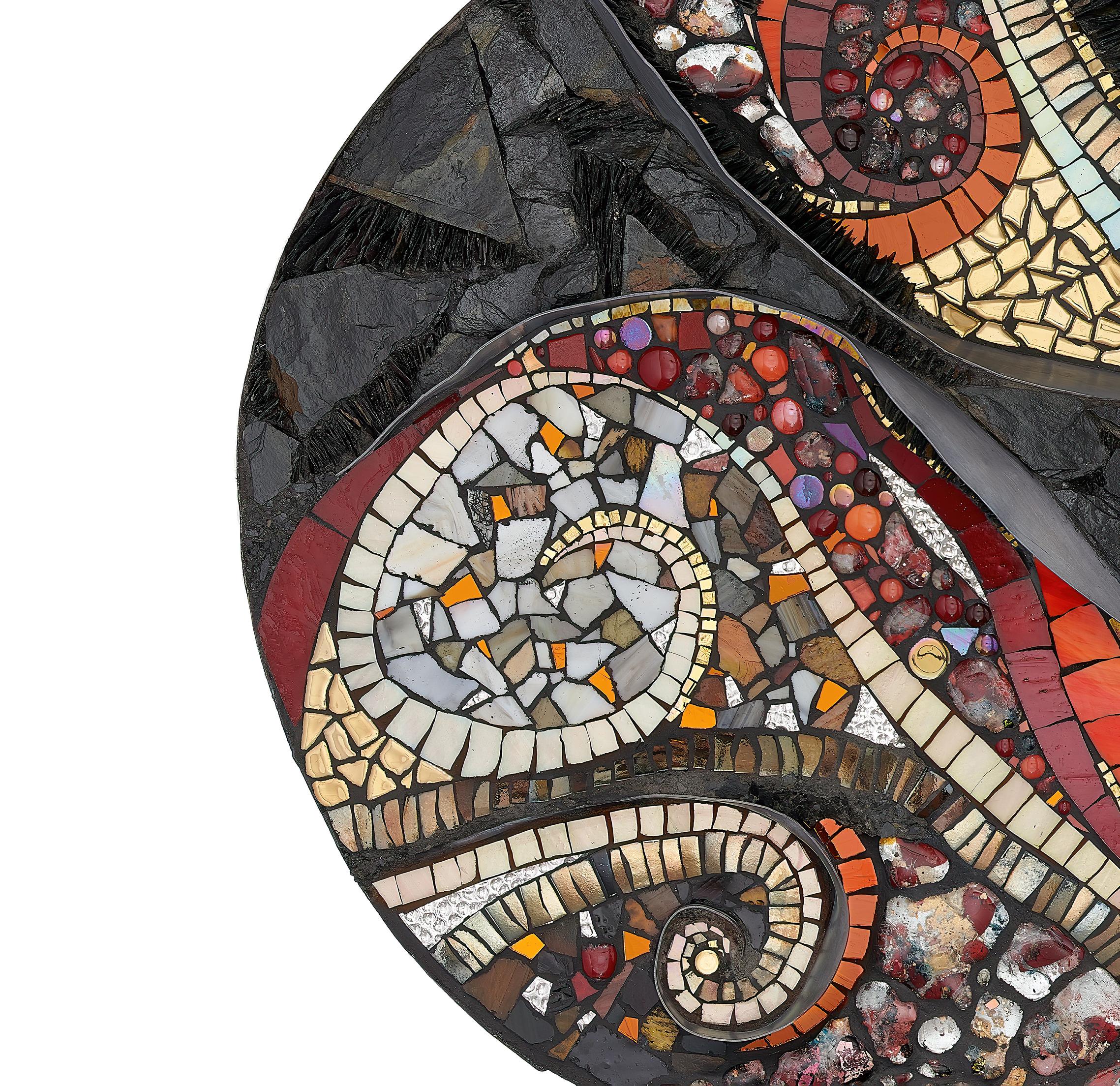 Rust and Slate (detail)
60 x 60cm Mixed media mosaic set into a rusted barrel ring. £1950
Rust and Slate (detail)
60 x 60cm Mixed media mosaic set into a rusted barrel ring. £1950